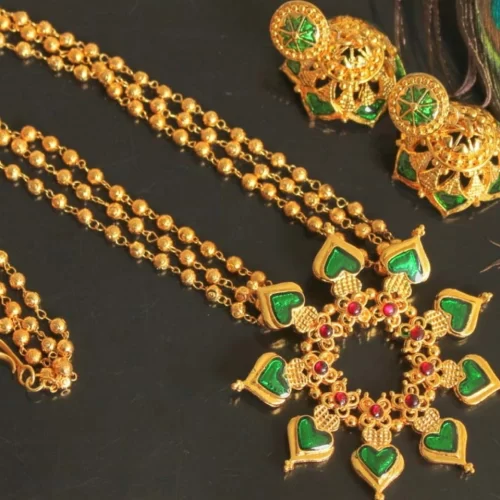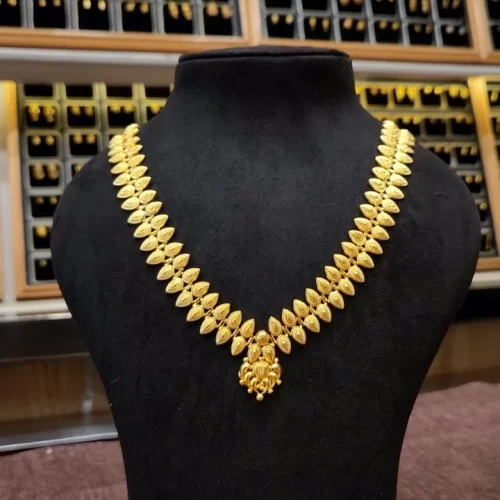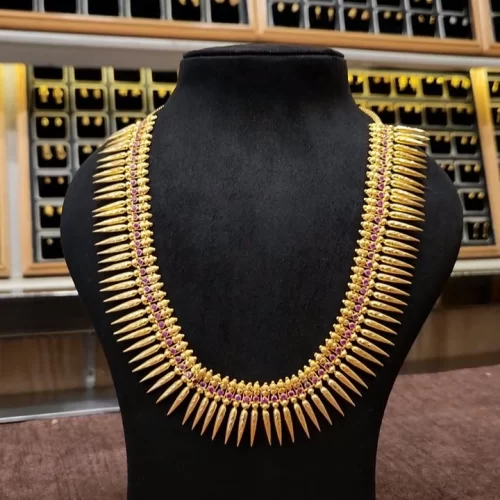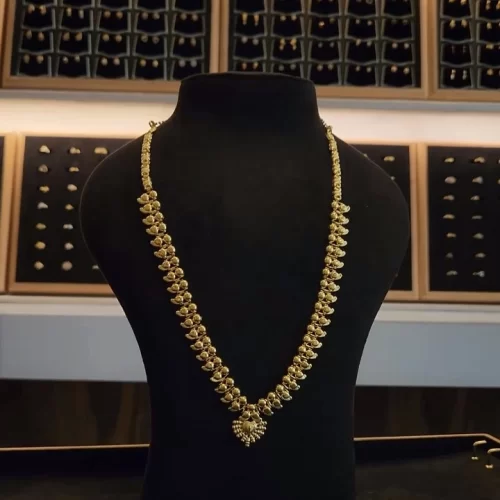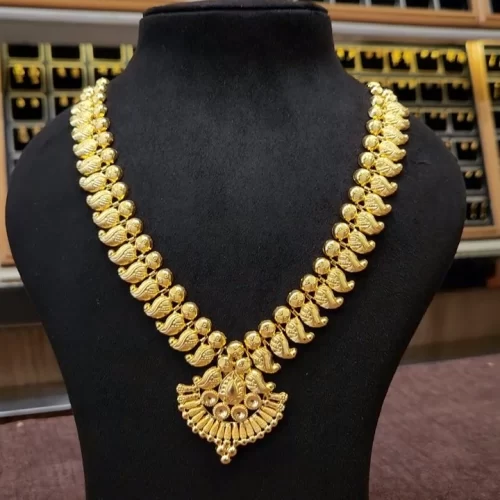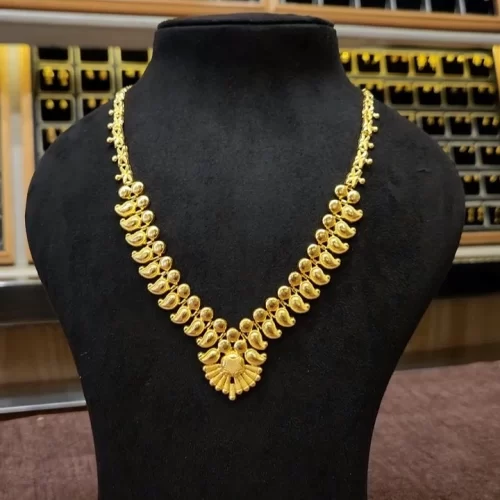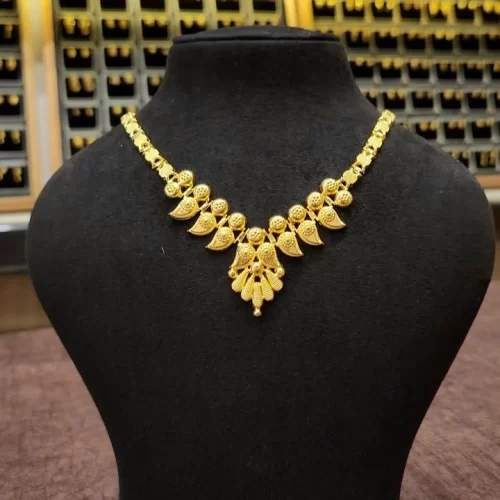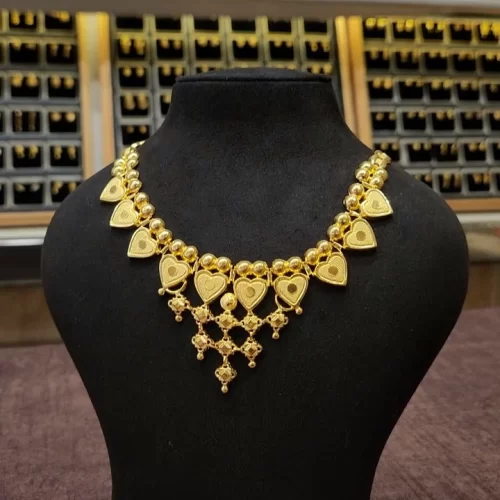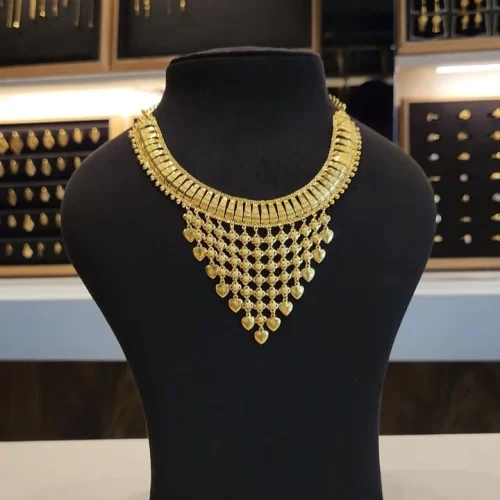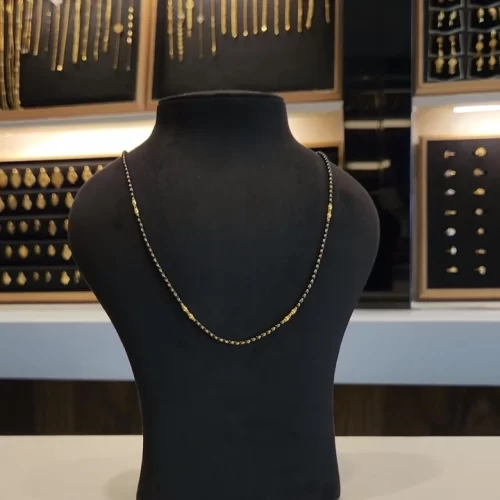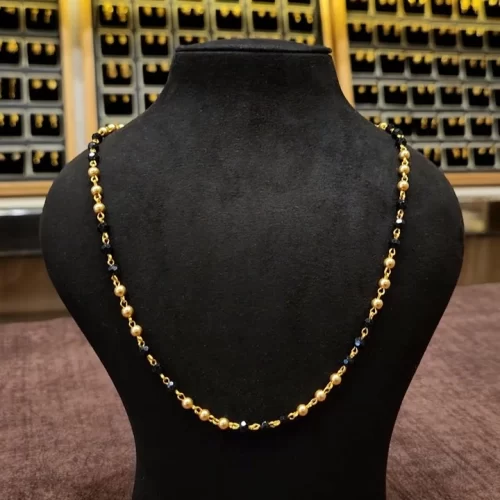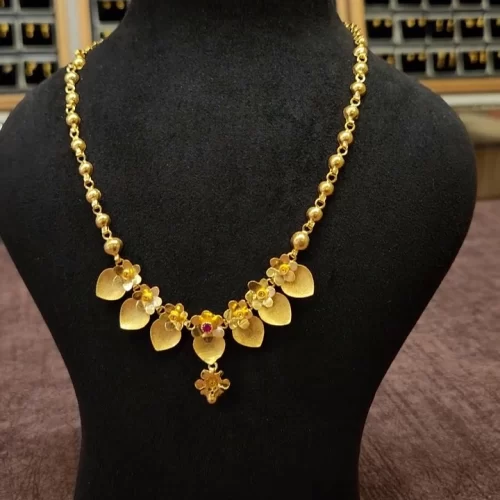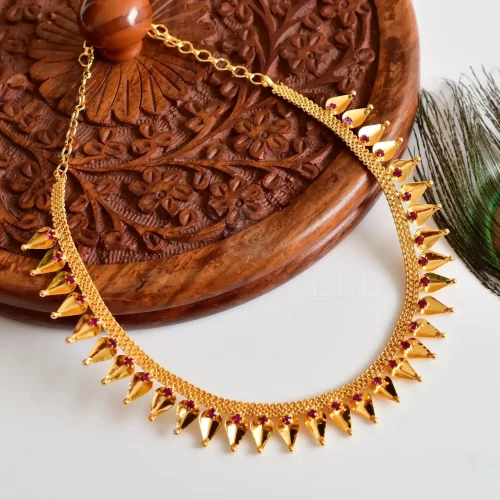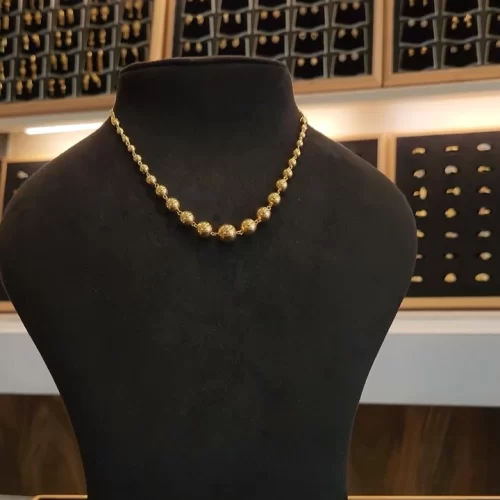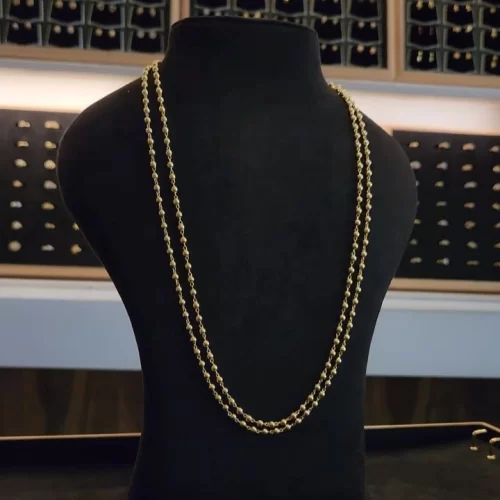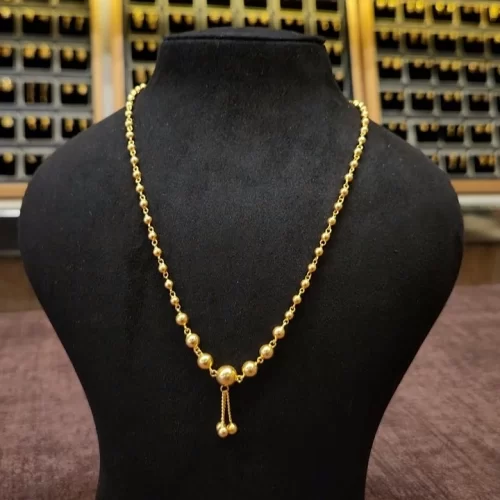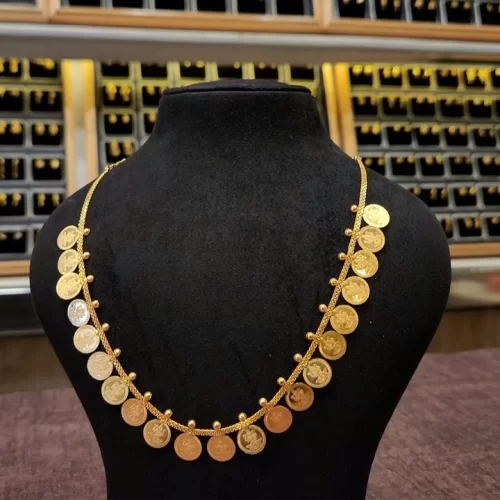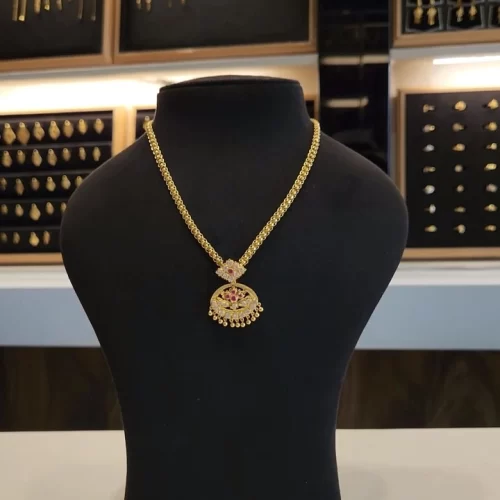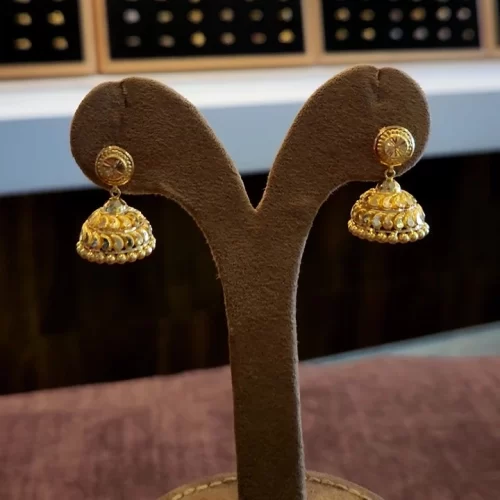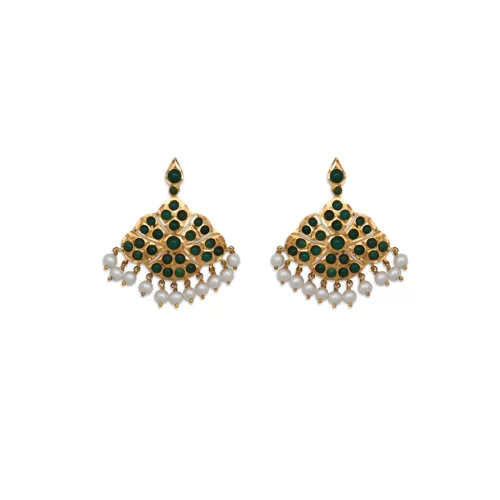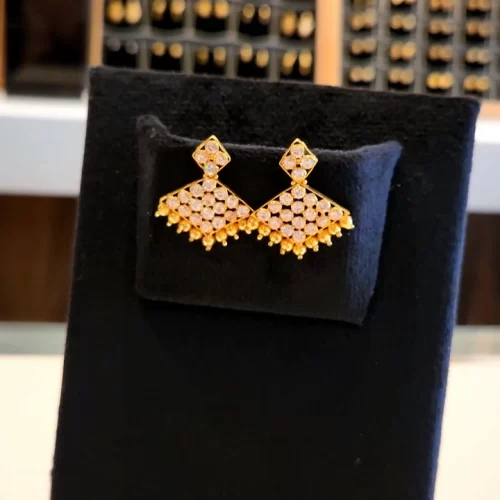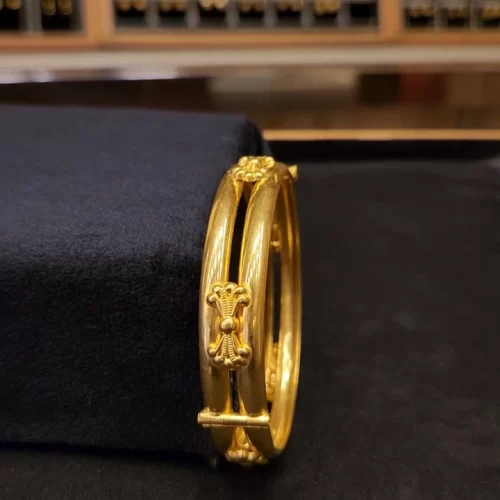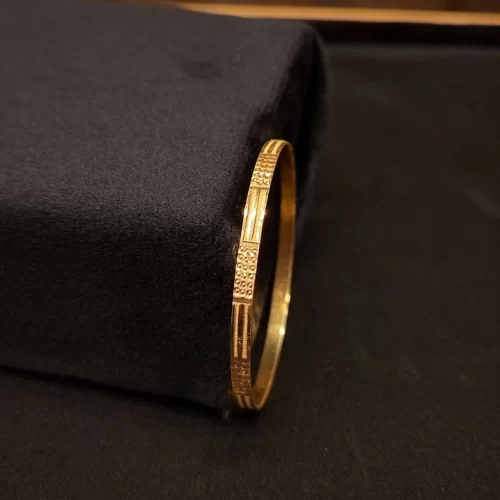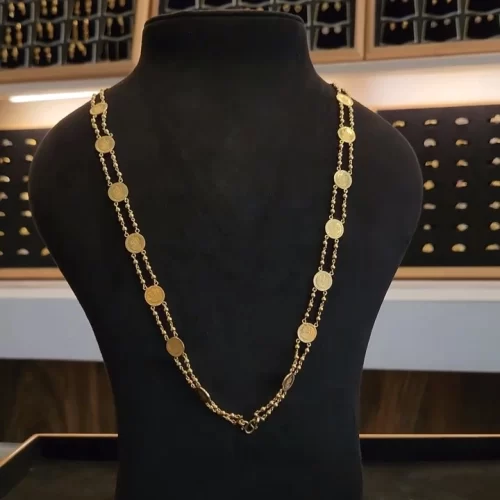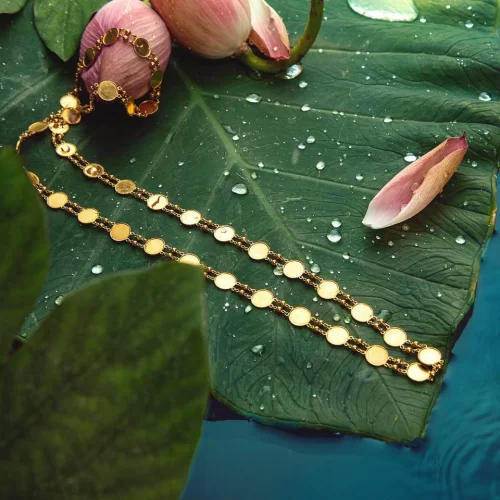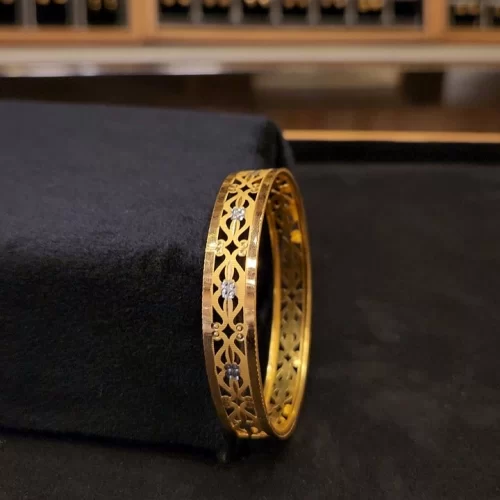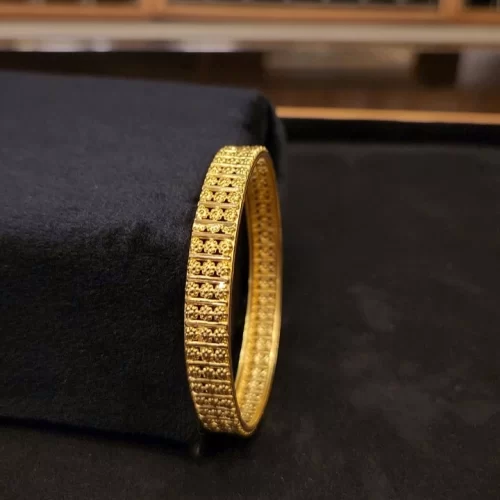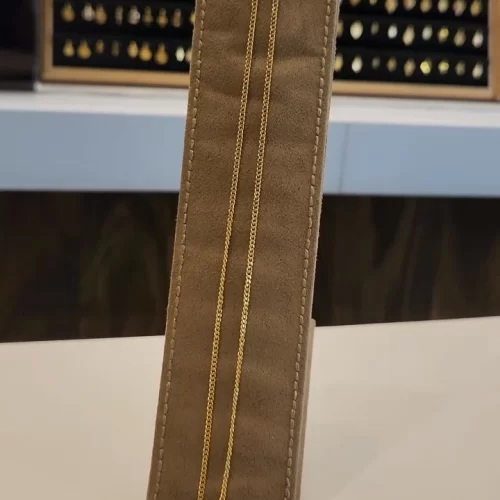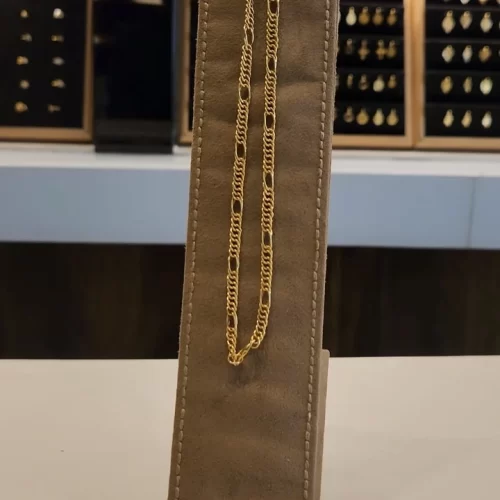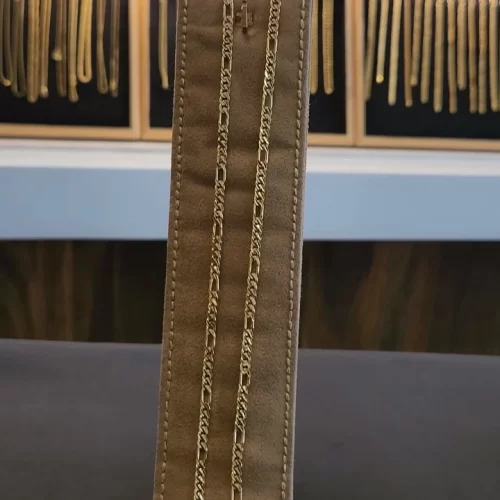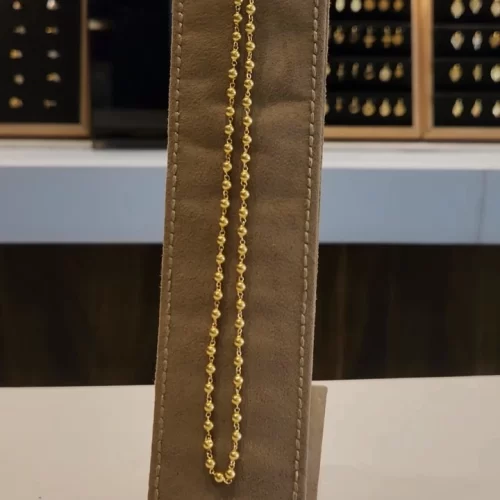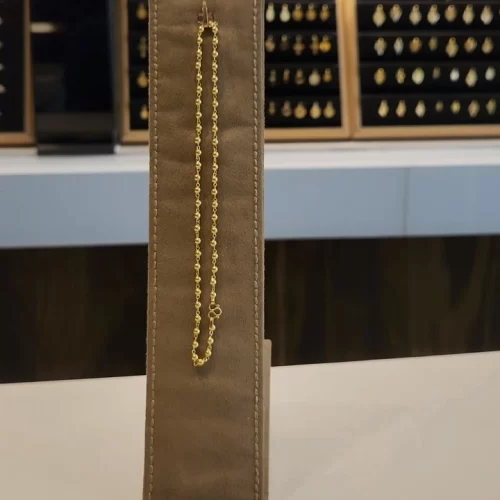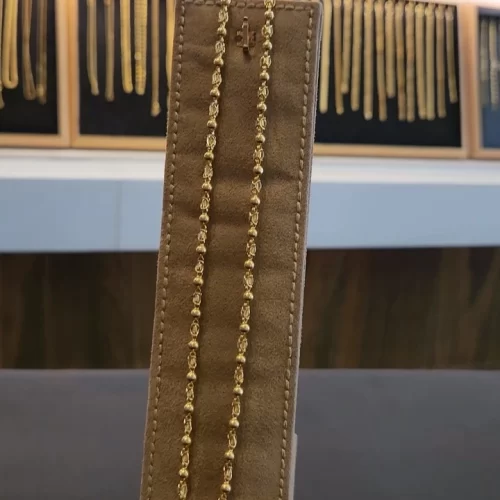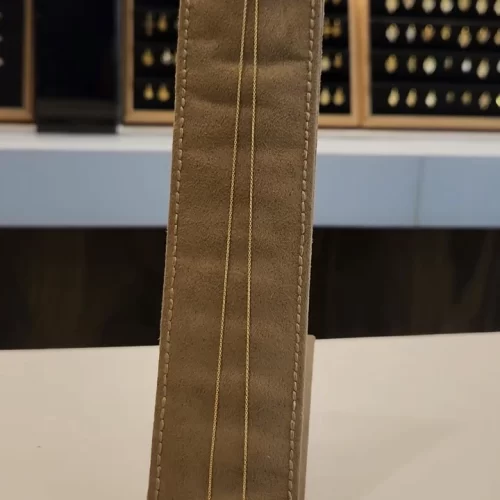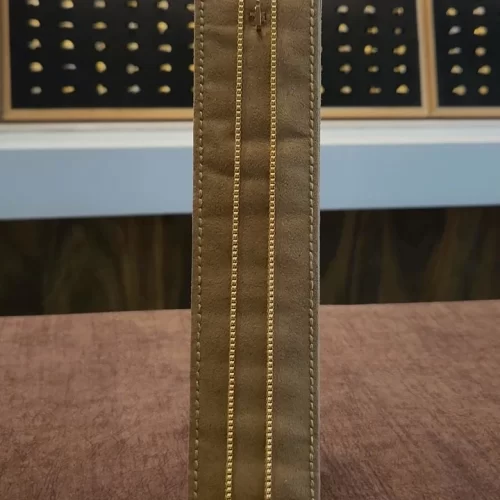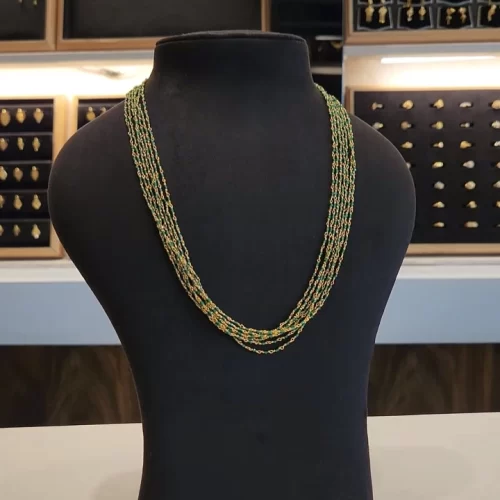Most Popular and Traditional Jewellery Designs of Kerala
Table of Contents
Step into the enchanting world of Kerala, a land blessed with timeless beauty and rich cultural heritage. Nestled along the southwestern coast of India, this captivating state is renowned for its stunning landscapes, vibrant traditions, and exquisite craftsmanship. Among its many treasures, Kerala boasts a long-standing tradition of intricate and captivating jewellery designs that have captivated hearts across the globe.
Palakka mala
Palakka mala, the most coveted traditional jewellery design in Kerala, holds a special place in the hearts of the people. Originally, this exquisite piece was crafted solely in green, symbolizing the lush greenery that blankets the state. However, with the evolving trends of modern fashion, the design has embraced a myriad of hues, expanding its colour palette to include captivating shades such as violet, red, blue, pink, and more.
Palakka mala manifests in various forms, catering to different preferences and occasions. You can find it in the form of chokers, palakka long harams (necklaces), pendants, bangles, and earrings, allowing individuals to adorn themselves with this cherished design in a style that resonates with their personal taste. The traditional palakka design is crafted in the shape of a leaf and typically adorned with glass or crystal inlays, adding a touch of sparkle and charm.
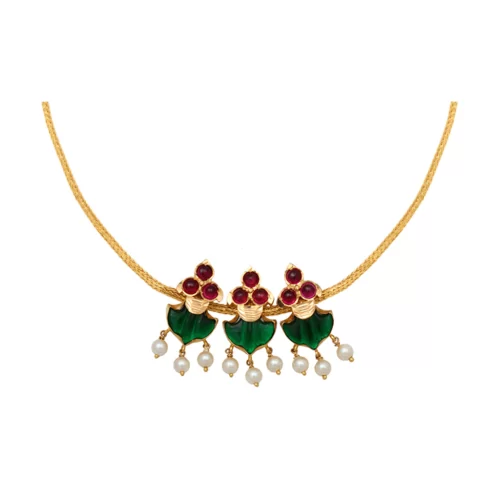
Beyond the leaf motif, the palakka mala also encompasses a diverse range of variations, each showcasing unique inspirations and aesthetics. One popular variation is the mango-shaped (manga) palakka, which adds a playful and vibrant element to the design. Another striking variation is the tiger-claw-shaped (pulinakham) palakka, adding an exotic touch to the jewellery. Additionally, creative fusions and innovative designs have emerged, offering a contemporary twist to the traditional palakka mala.

Traditionally, the intricate inlays of Palakka were meticulously set in heavy gold, exuding an air of elegance and grandeur. However, to cater to a wider range of budgets and preferences, palakka designs are now available in other metals and alloys, making this timeless beauty more accessible to all.
A traditional long palakka mala comprises 27 motifs or units on either side of the pendant. Which is also known as palakka mothiram. Although mothiram means ring in Malayalam, here it is referred to as a necklace that drapes around the neck like a ring. The number of motifs varies as per design.
Palakka mala, with its captivating leaf-shaped design and vibrant colour variations, continues to be cherished by the people of Kerala. It not only reflects the region’s natural splendour but also stands as a symbol of tradition, artistry, and cultural pride. As you delve deeper into the world of Kerala’s jewellery, let the allure of Palakka mala enthral you, connecting you to the rich heritage and timeless beauty of this exquisite adornment.
Mullamottu Mala
Jasmine flowers hold unparalleled importance in the South Indian states, where they are an integral part of every celebration and customary function. The Mulla mottu mala, meaning “garland of jasmine buds,” is a beloved necklace, particularly favoured by Kerala brides. It holds a special significance as a traditional heirloom, often passed down from grandmothers to their granddaughters in a ceremonial gesture known as “amadapetti.” This pure gold mullamottu necklace carries the essence of a rich cultural heritage, connecting generations and celebrating life in the Malayali way. In Karnataka, a similar necklace is known as mallimoggu sara.

The Mullamottu Mala is a traditional South Indian gold jewellery featuring motifs shaped like jasmine buds, delicately attached to a chain of gold. The term “Mullamottu” derives from the Malayalam language, where it refers to jasmine buds. This necklace design is slightly longer compared to other types of traditional gold necklaces. There is another variation called Pichimottu Mala, which differs in shape and design. In the Mullamottu Mala, the motifs are slightly rounded, resembling jasmine buds, while in the Pichimottu Mala, the motifs take an elongated form.
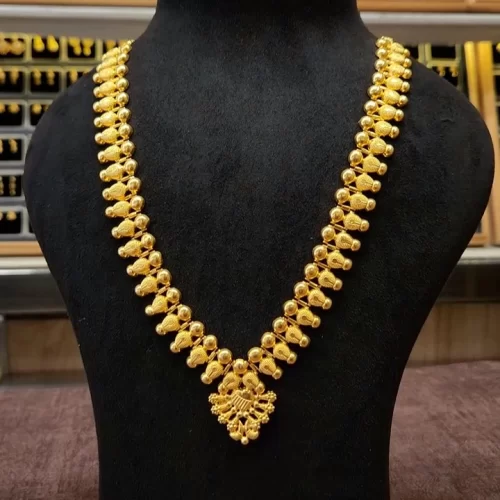
Inspired by nature, the Mullamottu Mala reflects the profound influence of flowers in Indian culture. Flowers like roses, marigolds, lotus, and especially jasmine, play a significant role in Hindu worship, where they are offered to gods and goddesses. White jasmine flowers are cherished for their divine fragrance, representing purity, love, and romance. Hence, it is no wonder that the Mullamottu Mala, symbolizing the beauty and purity of jasmine, has become an iconic piece of traditional bridal jewellery.
The Mullamottu Mala comes in various styles and designs. The necklace can be a long, elegant piece resting on the chest or a middle chain/necklace. Some versions feature a large pendant attached to the centre of the chain. The necklace can be crafted entirely from gold or adorned with precious or semi-precious stones such as ruby, adding a touch of vibrancy to the base of the chain. The Mulla Mottu necklace consists of a series of jasmine petals artfully strung together, creating a captivating floral necklace.
This traditional Kerala jewellery is available in two main designs. One design features plain gold jasmine petals, while the other combines gold jasmine buds with gemstones. The Mulla Mottu necklace holds great significance in Kerala bridal jewellery collections, making it a cherished piece found in the wardrobes of almost every Keralan woman.
Both the Mullamottu and Pichimottu Mala draw inspiration from the beauty of jasmine buds. The Mullamottu Mala’s rounded motifs evoke the gentle allure of jasmine buds, while the Pichimottu Mala showcases elongated motifs, adding a unique touch. As ancient symbols of beauty, love, purity, and prosperity, jasmine flowers hold a special place among Hindus, and the Mulla Mottu necklace beautifully captures their essence, adorning brides with elegance and grace.
Pichimottu Mala
Derived from the Pichi plant, a variant of Jasmine found in Kerala, the Pichimottu Mala showcases a design inspired by the buds of the Pichi plant. This traditional gold necklace is crafted by arranging the lockets in a captivating pattern. The Pichimottu Mala holds a special place as a popular piece of traditional jewellery in Kerala.
Similar to the Mullamottu Mala, the Pichimottu Mala features jasmine-bud-shaped motifs, but with variations in their shape. Depending on whether it is a Mullamottu Mala or a Pichimottu Mala, the motifs can be either rounded or elongated. This exquisite necklace consists of repeated motifs of elongated or rounded jasmine buds, beautifully crafted to form an enchanting piece of jewellery. Typically, the Pichimottu Mala is worn as the middle or last chain in a bridal jewellery ensemble, its placement depends on the length of the necklace. It is also referred to as “Pichimottu Mala” since “Pichimottu” also means jasmine in Malayalam, the language spoken in Kerala.
Both the Mullamottu Mala and Pichimottu Mala draw their inspiration from the elegance of jasmine blooms. While the Mullamottu Mala exhibits a more rounded design, reminiscent of the gentle curves of jasmine buds, the Pichimottu Mala showcases an elongated form of the bud. This necklace often exceeds the length of many other necklaces, creating an alluring line that enhances the regal appearance of the bride. Adorned with the Pichimottu Mala, the bride radiates grace and beauty, encapsulating the essence of the majestic jasmine flower.
Manga Mala
Manga Mala, a significant part of the traditional bridal trousseau in Kerala, showcases a unique design featuring beads or lockets shaped like mangoes. These mango-shaped elements are meticulously arranged to form a stunning manga mala necklace.
When it comes to Indian gold jewellery, the craftsmanship and designs are truly remarkable, with South Indian designs particularly known for their creativity and perfection. Kerala, a small South Indian state, holds a special place in the realm of South Indian gold jewellery, blending traditional designs with modern elements to create a refreshing look.
Each piece of traditional jewellery carries its own distinctive design and style, and among them, the Manga Mala stands out as an authentic traditional South Indian gold jewellery style.
This original mala features paisley motifs made of gold arranged in a sequential pattern along a gold chain or necklace, with each motif being linked to the chain. These paisley motifs are uniform in size and shape, encircling the entire necklace.
The term “Manga Mala” translates to “Mango Necklace” as the motifs attached to the gold chain resemble the shape of a mango. In Indian culture, the mango tree is considered a symbol of fertility, prosperity, and love, which likely inspired the design of this traditional gold jewellery piece.
The Manga Mala symbolizes prosperity, love, and wealth, making it an integral part of traditional weddings and festivals in India.
There are several popular variations of the Manga Mala, some of them are as follows:
- Classic Design: This variation is made of pure gold, featuring intricately designed paisley motifs. It can be worn alone at traditional events or layered with other gold necklaces for a wedding. If you appreciate untouched traditions, the classic design is perfect for you.
- Inlaid with Jewels, Pearls, and Semi-Precious Stones: This type incorporates diamonds, pearls, and other precious or semi-precious stones. However, it is important to ensure that these additional elements do not overshadow the distinctive “Manga” design, which is the highlight of the necklace. This medium-sized Manga Mala can be worn on its own, paired with neutral-coloured traditional outfits.
- Short Necklace: This variation features a few “Manga Motifs” linked to a small gold chain. If you prefer a small and simple design, this option will suit you.
- Peacock Design: This type combines two designs—the peacock’s feather and paisleys. To enhance its beauty, pair it with simple pieces of gold jewellery.
- Choker: The choker variation of the Mala consists of paisley motifs arranged in succession on a small gold chain that fits snugly around the neck. At the centre of the chain, two or three motifs may be arranged in a pendant-like fashion. Chokers may also be worn without pendants.
The Manga Mala, with its diverse designs, offers a range of options to suit individual preferences and complement various traditional ensembles.
Embodying the beauty of mangoes and symbolising prosperity, love, and wealth, this precious piece of traditional jewellery adds elegance and allure to any occasion.
Elakkathali
Elakkathali, as the name suggests, is a captivating collar necklace that exudes grace and elegance with its fluttering movement. This exquisite piece of jewellery is adorned with numerous tiny, thin leaflets that sway and reflect light in a mesmerizing manner, creating a sparkling illusion. Elakkathali holds a special place in the realm of Kerala’s cultural heritage, as it is prominently worn as an adornment during Mohiniyattam, the classical dance form of Kerala.
The Elakkathali choker necklace is highly polished, composed of delicate strands of gold that shimmer and gleam with every movement the bride makes. It sits prominently above all other necklaces she may choose to wear, making a statement and capturing attention. It is particularly favoured by Christian brides and those seeking to infuse a modern touch into their wedding attire.
This iconic piece of traditional jewellery from Kerala showcases intricate patterns and exquisite craftsmanship, emphasizing the allure and significance of gold in the cultural traditions of the region.
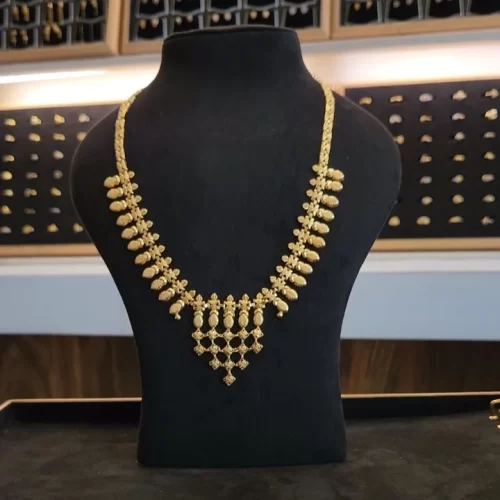
With its timeless beauty and ornate design, Elakkathali serves as a symbol of prestige and refinement, enhancing the beauty of every bride who adorns it on her special day.
Kazhuthila
Kazhuthila, a traditional type of gold jewellery from Kerala, India, exudes simplicity and elegance with its leaf-inspired design. This choker necklace is adorned with delicate gold leaf trinkets that are meticulously arranged, creating a captivating Kazhuthila. While not as widely recognized as the Palakka or Kasu mala, Kazhuthila necklaces truly accentuate the beauty of Kerala women.
Derived from the Malayalam words “kazhu” meaning “small” and “thil” meaning “seed,” Kazhuthila jewellery features intricate craftsmanship and the use of small, seed-like beads. These beads, usually crafted from gold but occasionally from materials like silver or coral, add a distinct charm to the jewellery. Skilled artisans handcraft Kazhuthila jewellery, employing traditional techniques that involve melting the gold, crafting intricate designs, adding the beads, and finally polishing the pieces.

Derived from the Malayalam words “kazhu” meaning “small” and “thil” meaning “seed,” Kazhuthila jewellery features intricate craftsmanship and the use of small, seed-like beads. These beads, usually crafted from gold but occasionally from materials like silver or coral, add a distinct charm to the jewellery. Skilled artisans handcraft Kazhuthila jewellery, employing traditional techniques that involve melting the gold, crafting intricate designs, adding the beads, and finally polishing the pieces.
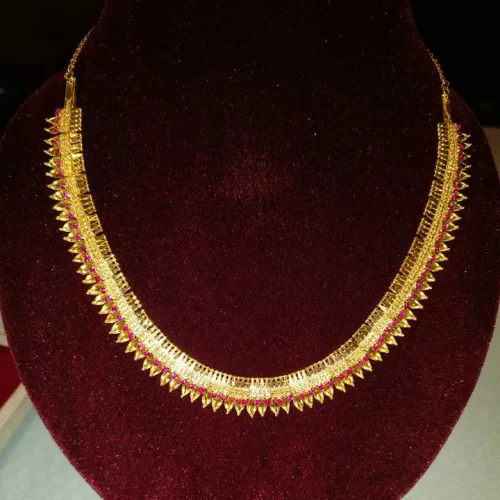
Kazhuthila jewellery holds a special place in the cultural heritage of Kerala and is often worn by women on significant occasions such as weddings and festivals. Its unique and beautiful designs make it a preferred choice for those seeking traditional jewellery options. Various types of Kazhuthila jewellery exist, including necklaces, earrings, bangles, and finger rings, each adorned with characteristic seed-like beads. These pieces can be simple or elaborate and can be worn individually or paired with other jewellery.
Wearing Kazhuthila jewellery allows individuals to embrace and celebrate the cultural traditions of Kerala while adding a touch of timeless beauty to their attire. Whether it is a Kazhuthila necklace delicately gracing the neckline or earrings shimmering with intricate beadwork, these pieces serve as cherished reminders of the rich heritage and craftsmanship of Kerala.
Kasu Mala
Kasu Mala, a traditional long necklace from Kerala, India, holds a special place in the culture and heritage of the region. The name “Kasu Mala” itself reveals its essence, with “kasu” meaning “coins” and “mala” denoting “necklace” in Malayalam. This necklace is characterized by a string of small coins that contribute to its unique charm and allure.
Considered a symbol of prosperity and power, the Kasu Mala was traditionally cherished by Nair and Namboothiri women in Kerala. Passed down through generations, it holds a significant position in the bridal trousseau of Kerala brides. The necklace has evolved with modern fashion trends, giving rise to various variants such as gold Kasu Mala, gold-plated versions, silver Kasu Mala, oxidized designs, and more. In Karnataka, this style of necklace is known as “kasinasara,” while in Andhra Pradesh, it is referred to as “kasulaperu.”

The Kasu Mala is intricately crafted by stringing together a multitude of coins to form a necklace. These coins often bear the embossed figure of Goddess Lakshmi, making the necklace also known as “Lakshmi Haar.” Goddess Lakshmi, the deity associated with wealth and prosperity, holds great significance in Hindu weddings. The Kasu Mala serves as a symbol of invoking her blessings for both material and spiritual abundance.
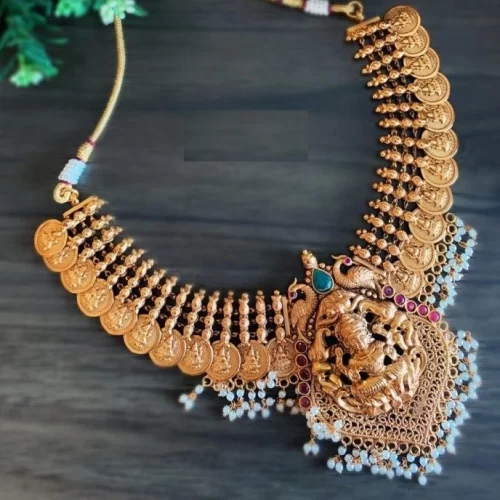
This necklace is a staple adornment in Kerala weddings, with its closely strung small gold coins. Each coin features a miniature carving of Goddess Lakshmi, symbolizing the invocation of her blessings upon the union and the bride. The Kasu Mala holds deep cultural and religious significance, representing the timeless beauty, prosperity, and auspiciousness associated with the Goddess Lakshmi and the sacred institution of marriage.
The Nagapada Thali
The Nagapada Thali, also known as Ottakal Nagapadam Mala, is a traditional necklace design from Kerala, India. The term “Nagapada” translates to “snake hood” in Malayalam, the language spoken in Kerala. The design of this necklace resembles the shape of a snake’s hood, hence the name Nagapada Thali.
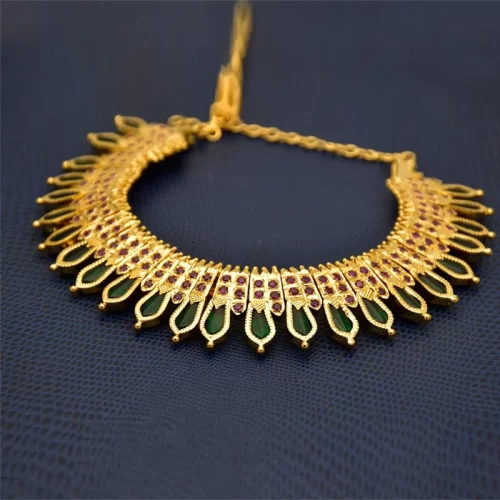
The Nagapada Thali is crafted with gold motifs adorned with green-coloured stones, often emeralds or other green semi-precious stones, as well as rubies. These motifs, shaped like snake hoods, are arranged in a sequence and attached to a gold chain. The overall design of the necklace is similar to the Palakka Mala, but instead of leaf-shaped motifs, it features serpent hood-shaped motifs.
This design holds significant cultural and religious importance in Kerala. Snakes have been revered and worshipped in certain religious traditions in the region, and wearing the Nagapada Thali is believed to offer divine protection and blessings. It is also associated with attracting wealth and prosperity. As a result, this traditional gold jewellery is often included in the bridal jewellery collection for traditional Kerala weddings.
The Nagapada Thali complements traditional Kerala attire such as the Kasavu Saree and Kerala Saree. Over the years, the colours and designs of the necklace have evolved, and modern-day women enjoy experimenting with pairing it with other outfits as well. Typically, the Nagapada Thali is worn as the outermost layer among other necklaces, particularly during weddings.
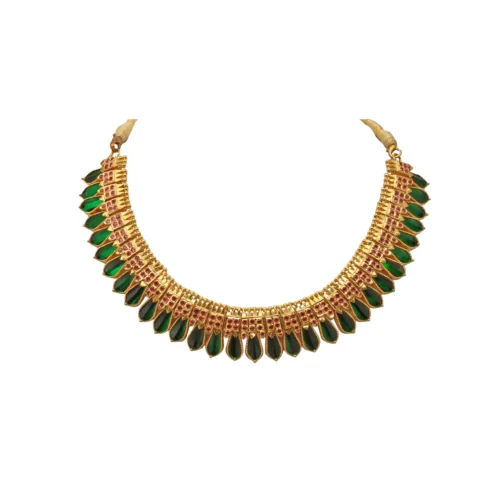
This necklace design is one of the oldest and carries the symbolism of the snake hood, which represents eternity and the three fundamental forces of creation, preservation, and destruction in Hindu culture. The Nagapada Thali is a treasured piece of traditional Kerala bridal wear and is crafted with gemstones or coloured glass set in a gold frame, reflecting the rich cultural heritage and reverence for the symbol of the snake.
The Pulinakham Mala
The Pulinakha Mala, also known as the Tiger Claw Necklace, is a delicate and traditional ornament from Kerala, India. Originally, the pendants shaped like tiger claws were worn by warriors in earlier times. Later on, skilled jewellers in Kerala crafted choker necklaces inspired by these tiger claw pendants, known as Pulinakha Mala.
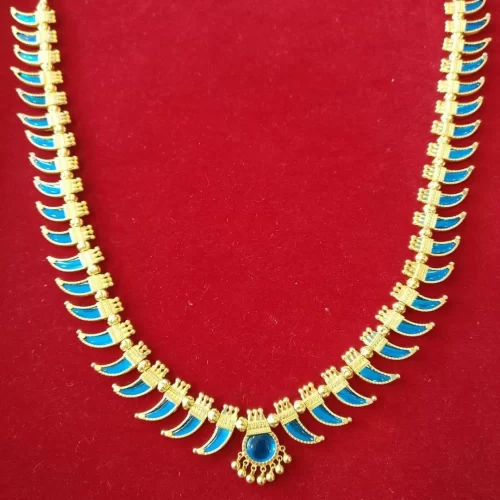
The term “Pulinakham” literally translates to “tiger’s nail.” In the Pulinakha Mala, glass stones are crafted in the shape of curved tiger’s nails and strung together to create a beautiful necklace. These glass stones can resemble emeralds or rubies, and when they are meticulously strung, they form a spectacular and classic piece of Malayali gold jewellery.
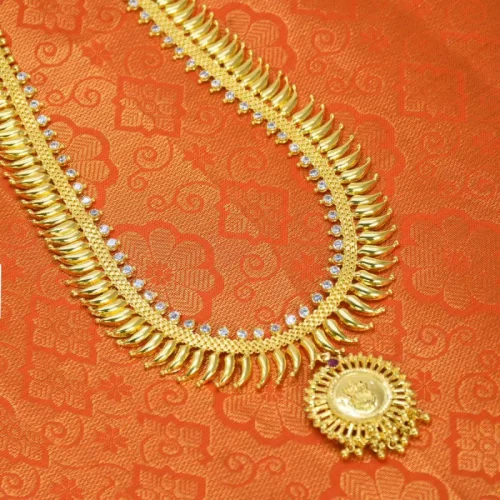
This timeless jewellery is typically adorned by Keralan women when wearing traditional Kerala sarees. The beads can come in various colours, and the necklace can be either a shorter, choker-style piece or a longer chain. Regardless of its length, it is a stunning and regal visual piece that leaves a lasting impression, reminiscent of the majesty of a tiger.
Karimani Mala
The design of Karimani Mala features a combination of black beads and gold beads. It is similar to the Mangalsutra worn by married women in North India. The term “Karimani” translates to “black beads” in the Malayalam language. The necklace typically includes a gold pendant, which may be embellished with precious or semi-precious stones. What distinguishes the Karimani Mala from the Mangalsutra is the use of only black beads along with gold beads, while the Mangalsutra may incorporate white, red, or black beads in addition to gold beads.
Traditionally, Karimani Mala’s designs tended to be on the heavier side compared to more modern versions. The necklace holds significance as a symbol of marriage and is worn by married women as a representation of their marital status. It is believed to bring well-being and long life to the husband.
In modern variations of Karimani Mala, various styles and designs have been introduced to cater to different preferences. These include traditional, cluster, ethnic, and contemporary designs. The pendant on the Mala can vary in shape, design, and colour. Additionally, modern Karimani Mala designs may incorporate diamonds, solitaires, rubies, pearls, and other precious or semi-precious stones.
Karimani Mala holds cultural and symbolic significance in Hindu marriages, representing the strength (Shakthi) denoted by the gold beads and the protection against evil provided by the black beads. While it may be less favoured by younger generations due to its length and weight, contemporary designs have been introduced to make it more appealing and versatile to different attire and style preferences.
Sarapoli Mala
Sarapoli Mala is a traditional gold necklace from Kerala, known for its simplicity and exquisite craftsmanship. It holds a special place in the traditional jewellery collections of Kerala and is often a piece that many individuals desire from their mother’s or grandmother’s jewellery box.
The Sarapoli mala features leaf-like motifs with a vertical fold in the centre, arranged in a choker or long chain setting to create a beautiful necklace. The design is timeless and continues to be cherished by young brides in Kerala.
The craftsmanship and attention to detail in Sarapoli mala highlight the skill of the artisans who create these pieces. The necklace symbolizes purity and represents the rich cultural heritage of Kerala.
The Sarapoli mala is a versatile piece of traditional jewellery that can be worn on various occasions, ranging from weddings to festive celebrations. Its elegance and simplicity make it an attractive choice that can enhance the overall look of the wearer.
Poothali Mala
The name “Poothali” is derived from the Malayalam words “poo,” meaning flower, and “thali,” meaning pendant or necklace. This necklace is characterized by floral designs etched onto its surface, showcasing its connection to nature.
The necklace is crafted using rectangular pieces that are intricately sculpted with flowers and leaves. It can be made of gold or silver, depending on personal preference and affordability.
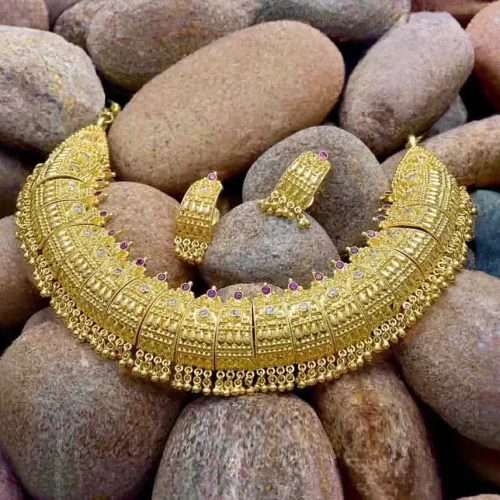
Variants of Poothali Mala include Kattapoothali and Thamara Poothali, which are also cherished by Kerala brides and find a place in their trousseau.
Poothali Mala holds cultural significance in Kerala and is often worn during special occasions such as weddings, festivals, and religious ceremonies. It exemplifies the beauty and elegance of Kerala’s traditional jewellery.
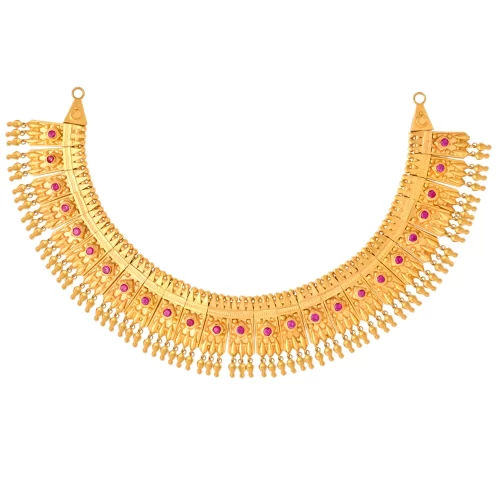
The origin of Poothali Mala can be traced back to the Malabar region of Kerala. The necklace draws inspiration from the floral garlands traditionally worn by women in the area. Over time, it has evolved into a distinct and cherished piece of jewellery, passed down through generations as family heirlooms.Tamara Poothali is a variant of the design that has been inspired by the Lotus flower (Thamara) and is loved by the people of Kerala.
Kuzhiminni Mala
Kuzhiminni Mala is a traditional necklace design that is cherished by women in Kerala, India. This necklace is crafted using gold and features a series of small, concave flower-shaped pendants that are linked together. The pendants are known for their unique hollow or depression in the centre, adding to their aesthetic appeal.
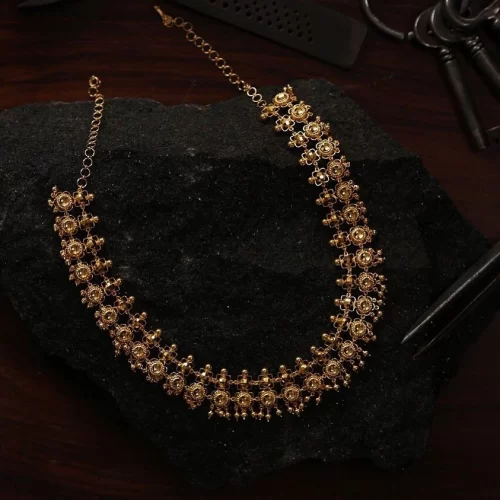
The pendants of Kuzhiminni Mala are often adorned with intricate filigree work or other delicate designs, showcasing the artistry and craftsmanship of Kerala’s jewellery makers. These necklaces are particularly popular and treasured during weddings, festivals, and religious ceremonies, where they add a touch of elegance and cultural significance to the wearer’s attire.
The term “kuzhiminni” is derived from the Malayalam words “kuzhi,” meaning “hollow,” and “minni,” meaning “flower.” The inspiration behind this design is believed to have come from the water droplets that form on the leaves of plants in the Malabar region of Kerala. The necklace captures the beauty and charm of nature, translating it into a stunning piece of jewellery.
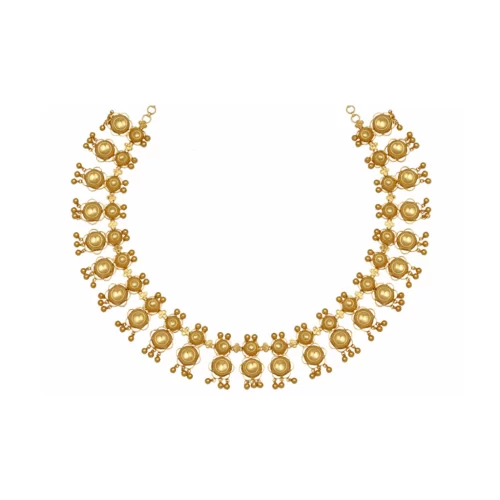
Kuzhiminni malas are not only valued for their aesthetic appeal but also hold sentimental value. They are often passed down through generations as cherished family heirlooms, symbolizing the rich heritage and traditions of Kerala. Additionally, these necklaces have become sought-after souvenirs among tourists, allowing them to take a piece of Kerala’s cultural legacy back home with them.
Whether worn for special occasions or as an everyday accessory, Kuzhiminni Mala exudes timeless beauty and serves as a reminder of Kerala’s artistic heritage. Its exquisite design and attention to detail make it a beloved adornment among women in Kerala and beyond.
Chandraminni
Chandraminni is a traditional necklace design in Kerala that showcases slim and sleek crescent moon shapes crafted in gold. These crescent moon motifs are arranged in a necklace setting, often with a centre piece, to create a stunning chandraminni necklace. This necklace design is considered rare and holds a special place in Kerala’s traditional jewellery repertoire.
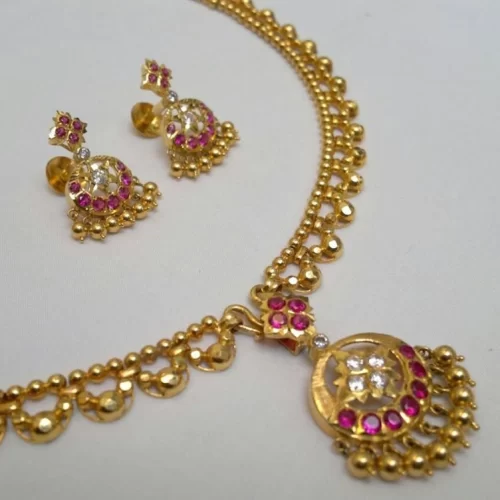
The chandraminni necklace is typically made of gold, which adds to its elegance and timeless appeal. The crescent moon shapes symbolize the waxing and waning phases of the moon, lending a sense of mystique and beauty to the design.
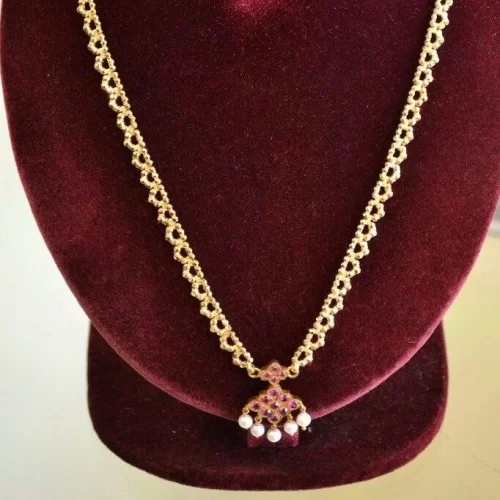
In some variations, the necklace may be further adorned with diamonds, rubies, or other precious stones, enhancing its allure and adding a touch of sparkle.
Chandraminni necklaces are particularly favoured by brides on their wedding day, as they embody sentiments of love, commitment, and prosperity. The necklace’s crescent moon shape represents the eternal bond between partners and is believed to bring good luck and blessings to the wearer. It serves as a cherished and meaningful adornment that is passed down through generations, carrying with it the blessings and well wishes of previous generations.
Kuzhal Mothiram Mala
The necklace consists of a series of small, round gold beads called kuzhalmothiram, which are strung together on a chain. These beads are typically around 1/2 inch in diameter and are made of 22-karat gold.
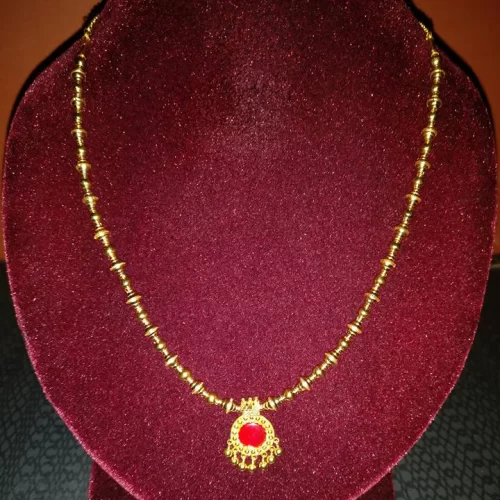
The kuzhalmothiram mala holds cultural significance in Kerala and is often passed down through generations as heirlooms. The necklace is considered a symbol of beauty, wealth, fertility, and prosperity.
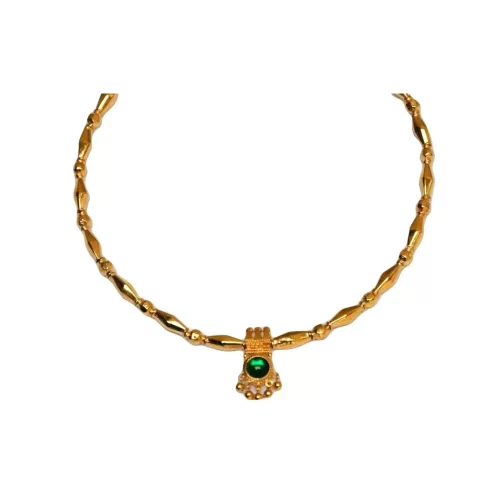
It is believed that the more kuzhalmothiram beads a woman wears, the more beautiful and prosperous she is considered to be.
The choker-style design of the kuzhalmothiram mala, often accompanied by a centrepiece stone inlay and side pieces, accentuates the beauty of the wearer’s neck.
Mani mala
Mani mala, also known as “ball chain necklace,” is a traditional gold necklace that is commonly found in households in Kerala. It is a simple necklace made up of small spherical gold beads, arranged in a string to form a garland-like design.
The mani mala is a versatile piece of jewellery that can be worn on a daily basis. It is often worn by women as an everyday accessory to add a touch of elegance and traditional charm to their attire.
The necklace can come in various lengths and styles, ranging from a single-layer chain to multiple layers, depending on personal preference.
The mani mala is considered a staple in Kerala’s jewellery collection due to its simplicity and cultural significance.
It is often passed down through generations as a family heirloom and holds sentimental value for many individuals. The necklace is also popularly gifted during special occasions such as weddings and festivals.
The term “mani” in Sanskrit means “bead” or “gem,” and “mala” means “garland” or “necklace.” The name “mani mala” reflects the nature of the necklace, which is a string of gold beads resembling a garland. The gold beads used in the mani mala are typically crafted with intricate designs, adding to their aesthetic appeal.
Overall, the mani mala is a cherished and widely worn piece of jewellery in Kerala, symbolizing tradition, elegance, and cultural heritage. Its simplicity and versatility make it a beloved accessory that can be worn by women of all ages and for various occasions.
Kandasaram
Kandasaram is a traditional choker necklace that is renowned for its regal and authentic South Indian design. It is a stunning piece of jewellery that exudes elegance and is often considered a symbol of royalty among Kerala’s traditional jewellery designs.
The Kandasaram necklace features a series of half-moon-shaped gold pieces stacked together, creating a visually striking pattern. The necklace is further enhanced with the addition of pink stones embedded in the design, adding a touch of colour and vibrancy to the overall aesthetic.
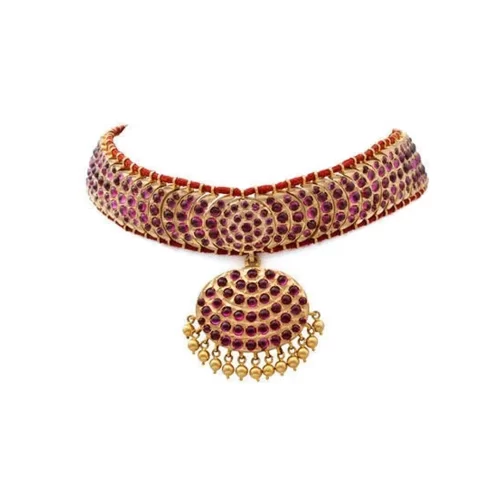
The intricate design patterns found in the Kandasaram necklace showcase the exceptional craftsmanship and skill of the goldsmiths of Kerala. The meticulous attention to detail and the artistry involved in creating this piece make it truly exquisite.

The Kandasaram necklace is typically worn on auspicious occasions, such as weddings, festivals, and other traditional ceremonies. Its regal and royal appearance adds a touch of grandeur to any outfit, making it a favoured choice among women seeking to adorn themselves with a piece of authentic South Indian jewellery.
Avil Mala
Avil Mala, also known as Havalakki Sara in Karnataka, is a traditional necklace design that takes inspiration from rice flakes, known as avil in Malayalam. The necklace features a series of long, bead-like elements that resemble puffed and flattened rice. This unique design is a testament to the artistry and craftsmanship of the skilled artisans who create these intricate pieces.
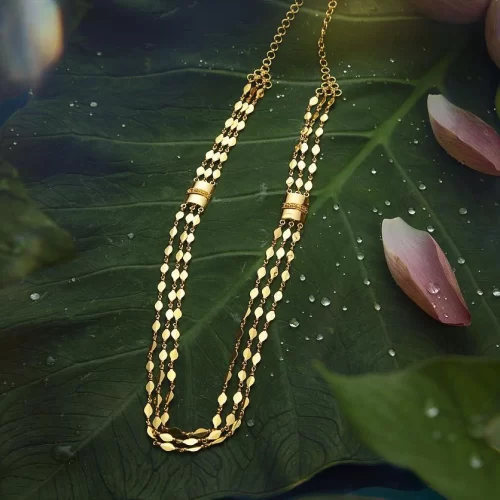
The Avil mala necklace is shorter in length compared to other traditional necklaces but is no less spectacular. The elongated beads, reminiscent of rice flakes, are strung together to form a beautiful neckpiece. Each bead is shaped like a petal, with a distinct contour in the middle and a gentle upward tilt.
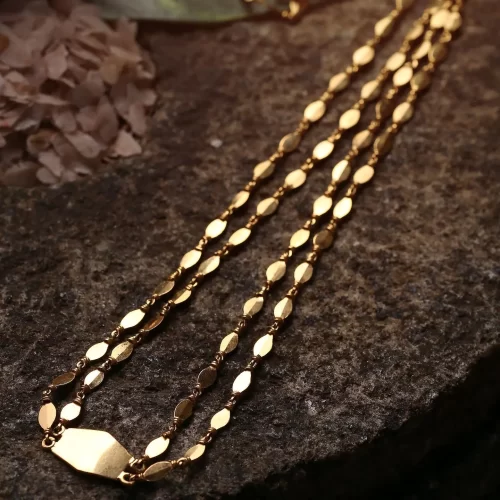
In Kerala, rice holds great cultural and symbolic significance. It is considered a symbol of abundance and good health, and it plays a prominent role in various rituals and ceremonies. The Avil mala necklace incorporates this symbolism, making it not only a stunning piece of jewellery but also a representation of prosperity and well-being.
The Avil mala necklace is often worn with an elegant Kerala saree, complementing the traditional attire. Its unique design and cultural significance make it a cherished accessory for special occasions and celebrations.
Kashali Mala
Kashali Mala is a variant of the traditional Kasu Mala, which features Lakshmi motifs on the coins. The main difference between the Kasu Mala and Kashali Mala is that the coins in the Kashali Mala do not overlap. Each coin is distinct and separate, showcasing intricate craftsmanship and attention to detail.
This traditional necklace holds great significance in Namboothiri culture, particularly among Namboothiri women. It is considered a sacred ornament and is believed to symbolize prosperity. The Kashali Mala prominently features Lakshmi motifs, representing the Hindu goddess of wealth and abundance. Additionally, some variations of the Kashali Mala may include Ganapathy motifs, showcasing Lord Ganesha.

The necklace is crafted with meticulous precision, with each “katta” (coin) individually standing out when strung together with gold noolu (string). The Kashali Mala is designed to enhance the character and beauty of each coin, creating a visually stunning piece of jewellery.
Gothambumani Mala
Gothambumani Mala, also known as Godambu Mala, is a traditional Kerala jewellery design that resembles a string of delicate wheat grains. Made of gold, this necklace is known for its sleek and delicate design, which enhances the features of the person wearing it. Gothambumani Mala is often preferred in both single and multiple layers by women in Kerala.

The necklace is crafted by stringing together slender gold links that mimic the shape and texture of wheat grains. The intricate design of the necklace accentuates the curves of the neck in an alluring way. It is a supple piece of jewellery that adds elegance and grace to the wearer’s attire.

Gothambumani Mala holds cultural significance and is typically worn during special occasions, such as weddings and festivals. It is believed to bring good luck and prosperity to the wearer. In the state of Karnataka, specifically among Kannadiga brides in the southern region, a similar necklace is known as Godhisara.
Pathakam
Pathakam is a traditional necklace commonly worn by Malayali brides in Kerala. It is an essential piece of jewellery that holds cultural significance and is often considered the first necklace in a bride’s jewellery collection. The necklace features a round pendant, which can be adorned with stones or designed in a palakka setting.
The Pathakam necklace is known for its simplicity and elegance. It can be worn alone and still capture attention and admiration. In South Indian states, this traditional necklace is commonly found, and in Karnataka, it is known as Padaka.
The pendant of the Pathakam necklace typically showcases the image of Goddess Lakshmi, symbolizing wealth and prosperity for the bride and her family. It is often encrusted with coloured gemstones, diamonds, or other precious stones. The pendant hangs from a broad gold chain, adding to the overall beauty and charm of the necklace.
The Pathakam necklace is cherished not only for its aesthetic appeal but also for its cultural significance. It is considered an important part of a bride’s jewellery collection, representing blessings of wealth and prosperity for the newlywed couple. The necklace holds sentimental value and is passed down through generations as an heirloom
Mukkolakkal Mala
Mukkolakkallu Mala is a traditional necklace specifically worn by young unmarried Namboothiri girls in Kerala. The necklace holds cultural and spiritual significance within the Namboothiri community.

One of the beliefs associated with Mukkolakkallu Mala is its ability to protect young girls from evil spirits such as Yakshis and Gandharvas. These spirits are believed to roam the earth and may be present in certain areas of Namboothiri households, as well as nearby grounds and sacred groves. The necklace serves as a safeguard against these spirits and provides a sense of protection to the wearer.
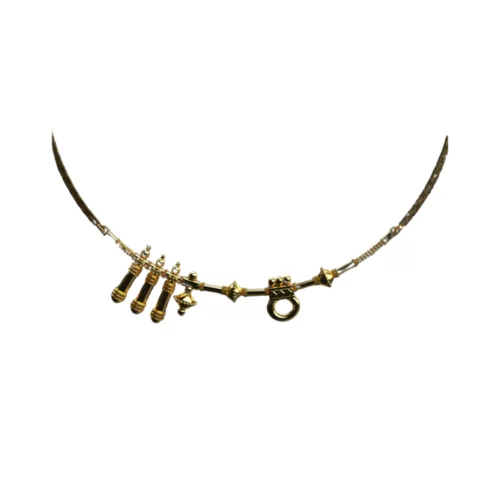
The Mukkolakkallu Mala is characterised by its simplicity and uniqueness. Namboothiri women typically prefer lightweight and understated jewellery, reflecting their satvik (pure) nature. This necklace follows the same principle and is designed to be simple yet significant.
Young Namboothiri girls wear the Mukkolakkallu Mala until they get married. At the time of marriage, the necklace is replaced by the thali, which is the wedding necklace symbolizing marital union and commitment.
Kingini Mala
Originally, Kingini Mala was worn as a hip chain by young kids, particularly resembling the adornment of Lord Krishna. However, its popularity grew, and women also began wearing it as a necklace.
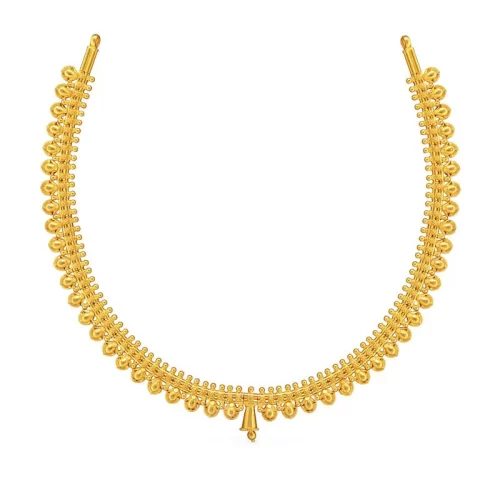
The design has since been adapted for various jewellery pieces, including hip belts, anklets, chokers, long necklaces, and bracelets.
The traditional Kingini Mala design featured a larger round bead as the centrepiece.
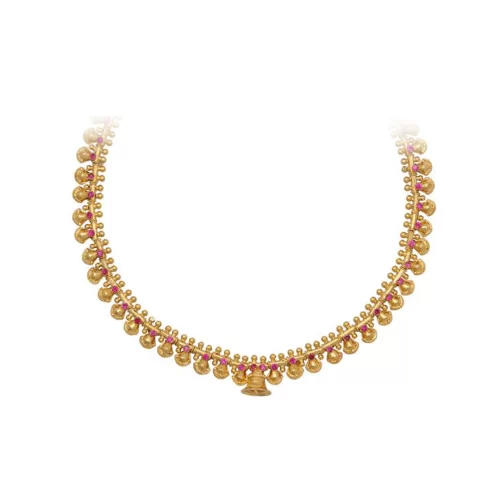
However, as time passed, this centrepiece gradually disappeared from the design, resulting in a continuous necklace without a central element. Both variations of the design, with or without the centrepiece, are equally attractive and cherished by wearers.
Moonizhamani Mala
Moonizhamani Mala is a stunning three-layered necklace that is part of Kerala’s traditional jewellery collection. It holds a special place among married Namboothiri women, who wear it with grace and elegance. The necklace is known for its intricate design and exquisite craftsmanship

The Moonizhamani Mala features three gold chains that are linked together, creating a layered effect. Each layer is adorned with beautiful gold beads and intricate detailing. The longest layer of the necklace often includes a pendant in the shape of a bodhi leaf, which adds a unique touch to the design. Additionally, a ruby stone inlay is commonly seen on the necklace, adding a pop of colour and further enhancing its beauty.
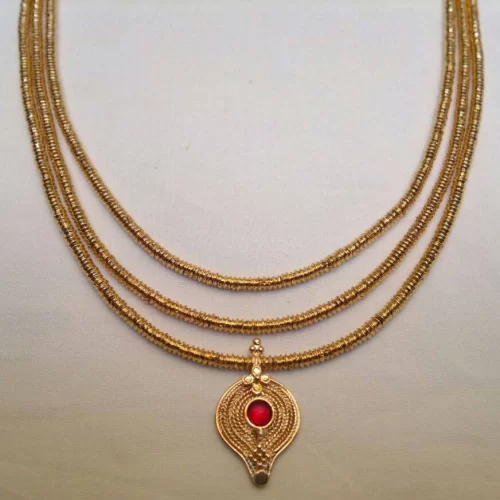
The necklace is often accompanied by a captivating mogra or Indian jasmine-shaped locket that is encrusted with sparkling gemstones. This intricate detail adds to the overall elegance and complexity of the design, making the Moonizhamani Mala a truly remarkable piece of jewellery.
Kumbil Mala
The necklace is characterized by a series of small, funnel-shaped cups that are intricately designed and strung together on a chain. The cups, resembling the shape of funnels, are made of 22-karat gold and can vary in design, ranging from simple and plain to intricately decorated.

The design of the Kumbil Mala is inspired by a leaf that has been folded into a funnel shape, traditionally used to hold and pour water. This nature-inspired design adds a touch of ethereal beauty to the necklace and gives it a distinct charm.
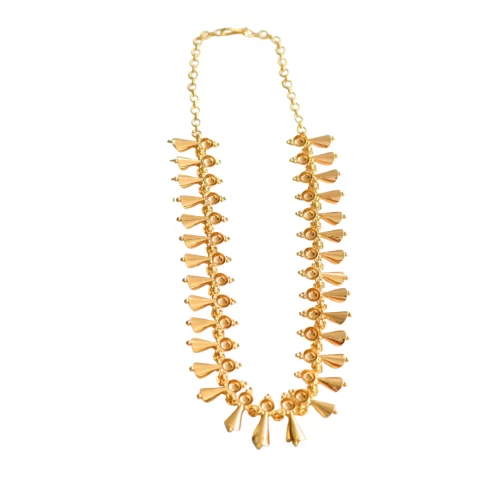
Kumbil Mala is often worn by women in Kerala as part of their traditional jewellery ensemble. It can be worn on its own or paired with other traditional ornaments, such as the thali (wedding necklace) and bangles. The necklace holds cultural significance and is considered a symbol of beauty and elegance.
Thalikoottam or Cheruthali
The necklace is characterized by a series of small, funnel-shaped cups that are intricately designed and strung together on a chain. The cups, resembling the shape of funnels, are made of 22-karat gold and can vary in design, ranging from simple and plain to intricately decorated.

Thalikoottam is a longer version of the malarthi thali, which consists of several malarthi thalis or lockets linked together. The malarthi thali is a pendant or locket that typically features intricate designs and is often adorned with precious gemstones. In the Thalikoottam necklace, multiple malarthi thalis are strung together to create a longer and more elaborate piece of jewellery.

The Thalikoottam necklace can be worn alone as a statement piece or paired with other necklaces for a layered and more elaborate look. It is a symbol of tradition, elegance, and cultural heritage. The intricate craftsmanship and attention to detail in the design make Thalikoottam a prized possession and a cherished part of a bride’s jewellery collection.
Malarthi Thali
The Malarthi Thali is a unique variation of the traditional thalikoottam necklace worn by Namboothiri brides, who belong to the Brahmin community in Kerala. It is a shorter version of the necklace and holds significant cultural and religious significance.The distinguishing feature of the Malarthi Thali is its design, which is shaped like an inverted or upturned leaf. This leaf-shaped locket is typically made of gold and is intricately designed. It symbolizes nature, fertility, and prosperity, reflecting the close connection between the Namboothiri community and the environment.
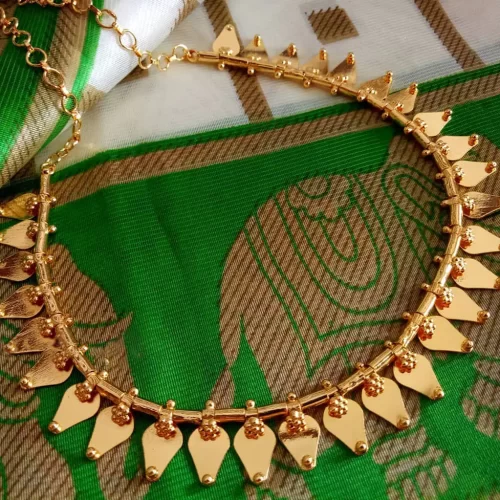
In the Namboothiri community, the Malarthi Thali is considered equivalent to the mangalsutra, which is a sacred necklace worn by married women in many other Indian cultures. It represents the marital bond and is a symbol of the woman’s married status. The Malarthi Thali is given to the bride by the groom during the wedding ceremony, signifying their union and commitment to each other.
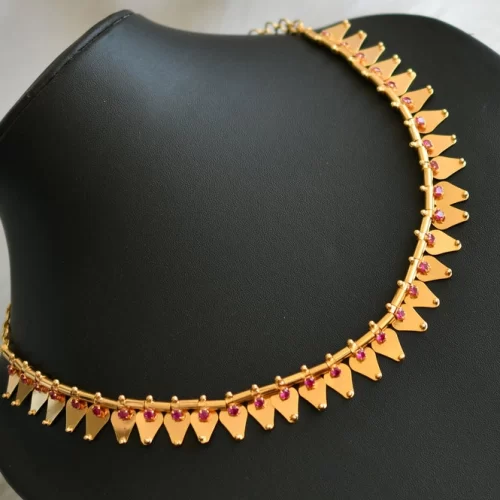
The Edakkanni thalikkoottam is a variation of the thalikoottam necklace that includes multiple Malarthi Thalis connected by “kanni” or links. This design allows the necklace to be worn as a longer piece rather than a close-fitting necklace, adding versatility to the ornament.
Kamizhthi thali
The Kamizhthi Thali is a distinctive variation of the Thalikkoottam necklace worn by Namboothiri brides, who belong to the Brahmin community in Kerala, India. It is one of the two designs of the Thalikkoottam, with the other design being the Malarthi Thali.
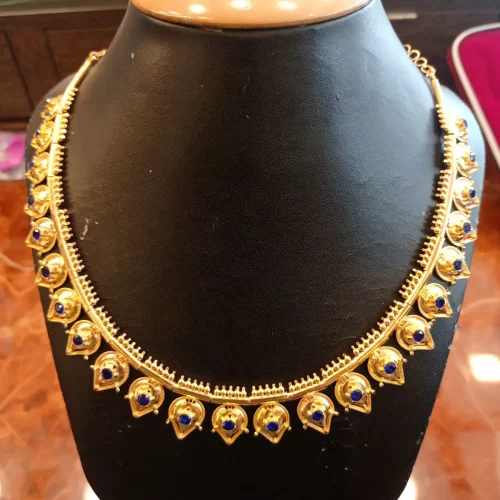
The Kamizhthi Thali showcases exquisite craftsmanship and intricate detailing. Each thali, or pendant, is shaped like a delicate leaf arranged upside down, creating a unique and elegant design. The ends of the thali feature fine arimbu work, which is a decorative technique involving intricate patterns and designs.
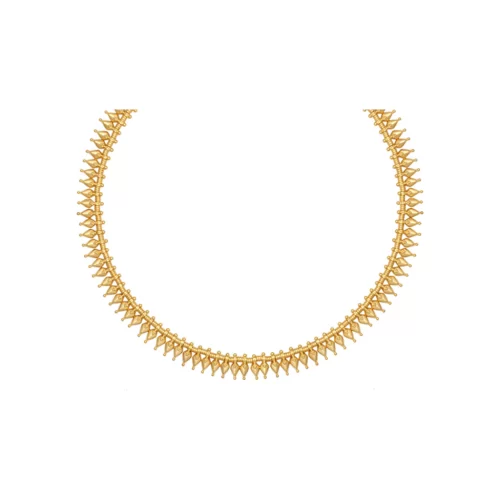
In the Kamizhthi Thali, the leaf-shaped thalis are strung on a gold thread, alternating with manis. The manis are glimmering beads or gemstones that add a touch of sparkle to the necklace. The alternating pattern of leaf-shaped thalis and manis creates a visually appealing and captivating design.The Kamizhthi Thali is highly favoured by brides for its stunning and intricate design. The Kamizhthi Thali, along with the Malarthi Thali, is a cherished ornament worn by Namboothiri brides. It reflects the cultural heritage, traditions, and aesthetic sensibilities of the community.
Lakshmi mala
Lakshmi mala, also known as Lakshmi haar, is an essential and auspicious jewellery set for Kerala Hindu brides. The necklace is composed of a series of coins, each engraved with the image of Goddess Lakshmi. In Hindu religious beliefs, Lakshmi is regarded as the symbol and bringer of wealth, prosperity, and good fortune.
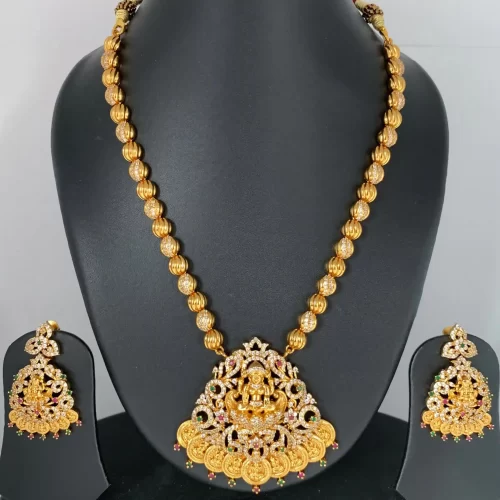
The Lakshmi mala holds significant importance in Kerala weddings. The necklace consists of multiple gold coins strung together, forming a continuous chain. Each coin bears the embossed image of Goddess Lakshmi, representing her divine blessings and auspiciousness.
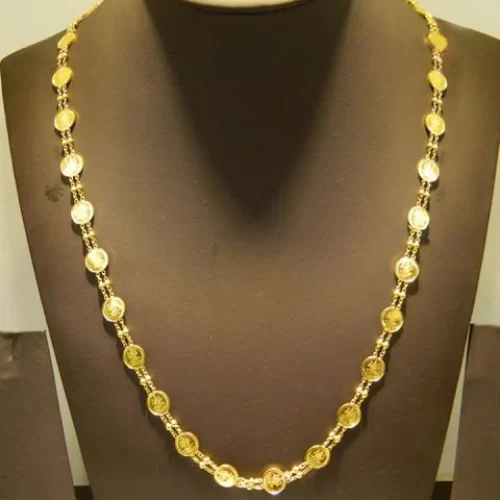
The presence of Lakshmi in the form of these coins is considered highly propitious for the bride and the wedding ceremony. The necklace serves as a symbol of prosperity and invokes the blessings of Goddess Lakshmi for the couple’s material and spiritual success.
Lakshmi Mala is not limited to Kerala weddings alone but is also a popular choice for various festive occasions and cultural celebrations in India. Accompanied by its counterpart the Lakshmi bangle, It is an embodiment of traditional craftsmanship and devotion to the divine feminine energy of Goddess Lakshmi.
Mandara Mala
The Mandara Mala is a captivating piece of jewellery that derives its name from the Mandara flower. In Hindu mythology, the Mandara flower is described as a heavenly bloom with a mesmerizing fragrance. It holds a sacred significance and is often associated with celestial realms.
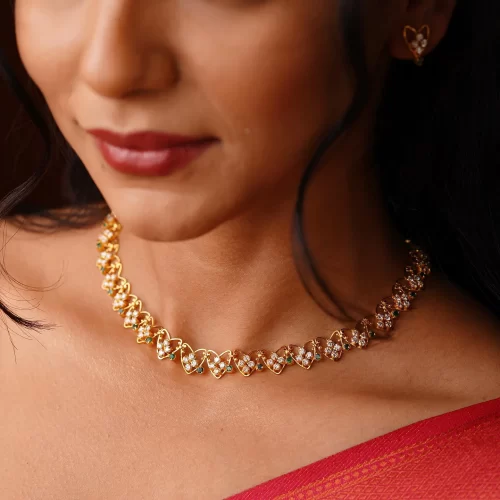
The Mandara Mala is designed to resemble the Mandara leaves, with intricately handcrafted gold frames adorned with diamonds and emeralds. The use of precious gemstones adds a touch of elegance and brilliance to this statement necklace.
The craftsmanship involved in creating the Mandara Mala is meticulous, with attention to detail in replicating the beauty of the Mandara leaves. The combination of diamonds and emeralds accentuates the allure of the necklace, making it a stunning piece of jewellery to behold.

The Mandara Mala not only showcases exquisite design and craftsmanship but also carries symbolic meaning. It represents the divine beauty, fragrance, and sacredness associated with the Mandara flower. The necklace is a testament to the rich cultural and spiritual traditions of India and holds a special place in jewellery collections for its unique and captivating charm.
Pavithrakettu Jewellery
The Pavithrakettu Jewelry is a traditional and sacred ornament that holds a mythical tradition in Kerala, particularly in the Payyannur village of the Kannur district. It is closely associated with the Payyannur Subramanya Swami Temple.
Originally, the Pavithrakettu was made of Darbha grass, and it was worn during the rituals of pithru bali, which is a prayer for the ancestors. The temple used to insist on wearing grass rings during these holy rites. Over time, the Pavithra ring transitioned into being made of gold or silver, and its design resembles a knot.
The Pavithrakettu ring is worn on the right ring finger during poojas and rituals for the deceased ancestors. It is believed to bring both material well-being and spiritual elevation to the wearer. The word “Pavithra” translates to pure and holy, reflecting the sacred nature of the ring.
The design of the Pavithrakettu holds symbolic significance. The three lines on each side of the knot represent the three Nadis (Ida, Pingala, and Sushumna) in the human body. The seven buds on each line represent the Seven Rishis (Ascetics) of the cosmos. The knot at the centre represents the glands in our body, and the three knobs adjacent to the knot symbolize the Trinity of Brahma, Vishnu, and Siva. Additionally, there are flattened knobs representing the Sun and the Moon.
Apart from its use during meditation and prayers, the Pavithrakettu is worn on special occasions such as Homa and other religious rituals. It is believed that wearing the ring helps maintain inner purity, concentration, courage, and peace of mind. It is important to wear the ring with a clean body and mind, and there are certain guidelines, such as refraining from wearing it during the menstrual period and avoiding alcohol and non-vegetarian food while wearing it.

The Pavithrakettu ring is typically worn on the right ring finger, as each finger in Hindu Shastras is associated with different elements and symbolism. It is considered a significant piece of jewellery that embodies sanctity, tradition, and spiritual essence.
In addition to rings, Pavithrakettu designs are now available in earrings and necklaces, offering a wider range of options for those who appreciate its mystical patterns and cultural significance. It is considered one of the unique and exquisite jewelry designs of Kerala, adding to the rich heritage of adornments in the state.
Dasavatharam jewellery
Dasavatharam jewellery is a type of jewellery that holds significant religious and cultural value in Hinduism. It portrays the ten avatars or incarnations of Lord Vishnu, who is considered the preserver and protector in Hindu mythology. The jewellery is crafted in various forms, such as pendants, necklaces, rings, earrings, and bracelets.
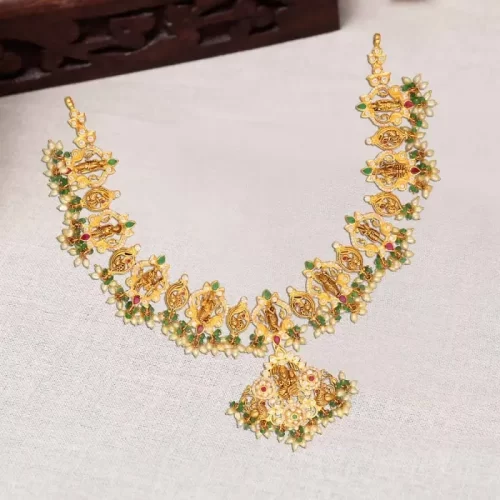
The ten avatars of Lord Vishnu, depicted in Dasavatharam jewellery, are as follows:
- Matsya (fish): Symbolizes the preservation of life during a great flood.
- Kurma (tortoise): Represents stability, strength, and support.
- Varaha (boar): Symbolizes the rescue of the earth goddess from the demon Hiranyaksha.
- Narsimha (half-man, half-lion): Represents the triumph of good over evil and the protection of devotees.
- Vamana (dwarf): Signifies humility and the conquering of ego.
- Parashurama (warrior): Symbolizes valour, courage, and the defence of dharma.
- Rama (prince): Represents righteousness, honour, and adherence to duty.
- Krishna (cowherd): Symbolizes divine love, joy, and the embodiment of divine playfulness.
- Buddha (enlightened one): Represents enlightenment, wisdom, and compassion.
- Kalki (messiah): Symbolizes the future avatar who is believed to bring the end of the current age and restore righteousness.
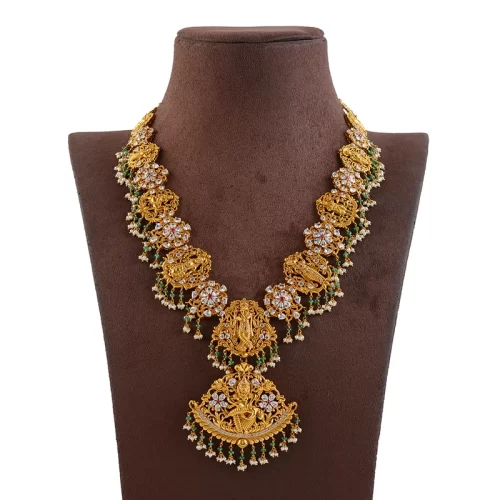
Dasavatharam jewellery serves as a spiritual reminder of the divine manifestations and qualities of Lord Vishnu. Because it is available in necklace and earring form, It holds great significance during religious festivals, ceremonies, and auspicious occasions in Hindu culture. The jewellery is often crafted with meticulous attention to detail, incorporating precious metals like gold or silver and embellishments such as gemstones to enhance its beauty and value.
Gowrishankaram Mala
The gowrishankaram necklace, with its rich cultural and religious significance, has also found resonance in the beautiful land of Kerala. Known for its deep-rooted connection to spirituality and traditional arts, Kerala embraces the allure of the gowrishankaram necklace with great reverence.
Within the vibrant cultural tapestry of Kerala, the gowrishankaram necklace holds a special place. It has been embraced by the devout followers of Lord Shiva, particularly those belonging to the Nair community, who hold Shiva in high regard. The necklace symbolizes the sacred union of Lord Shiva and Goddess Parvati, known as Gowri in this region. By wearing the gowrishankaram necklace, men in Kerala aim to tap into the divine energies and qualities embodied by Lord Shiva.
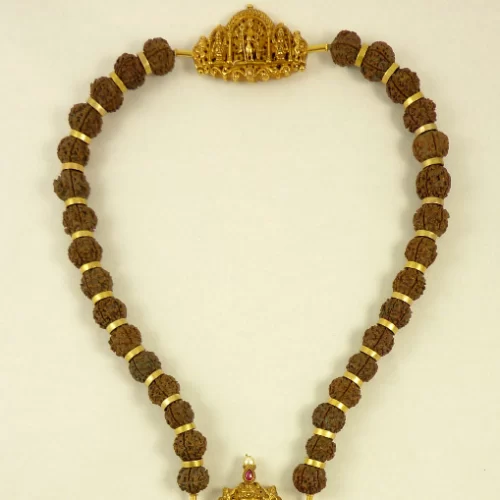
In Kerala, the gowrishankaram necklace is crafted with intricate detail and craftsmanship. It often features Rudraksha beads, which are synonymous with Lord Shiva, reflecting the profound connection to the deity. Alongside the Rudraksha beads, strings of gold beads are sometimes incorporated, adding a touch of opulence and elegance to the necklace.
The centrepiece of the gowrishankaram necklace in Kerala showcases captivating pendants that narrate divine stories. These intricately designed pendants depict various forms of Lord Shiva and Goddess Parvati, such as their blissful ride on the sacred bull, Nandi, accompanied by their sons Ganesh and Karthik. Another pendant may portray the dynamic image of Lord Nataraj, where Lord Shiva dances triumphantly over a demon, symbolizing the triumph of knowledge over ignorance.
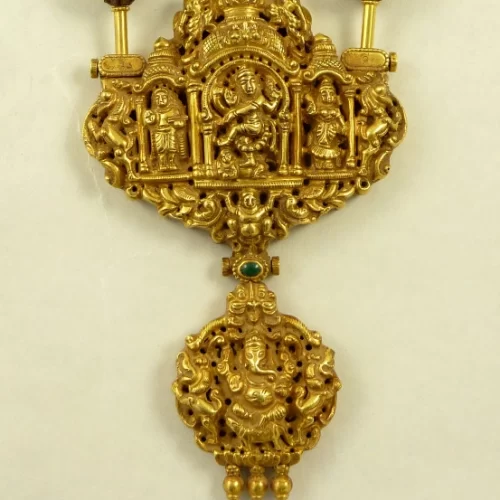
A unique feature of the gowrishankaram necklace in Kerala is the inclusion of small, box-like attachments hanging below the pendants. These attachments serve as miniature shrines, allowing for the storage of lingams or portable deities. This transforms the necklace into a sacred and portable shrine, enabling the wearer to carry their divine connection wherever they go.
Soochi Mulla Mala
Soochi Mulla Mala, also known as Soochimala or Soochimalai, is a traditional Kerala jewellery with a unique design of small gold needles. These needles are intricately linked together to form a necklace. The craftsmanship involved in creating a Soochi Mulla Mala is highly skilled and showcases the artistry of Kerala’s goldsmiths.
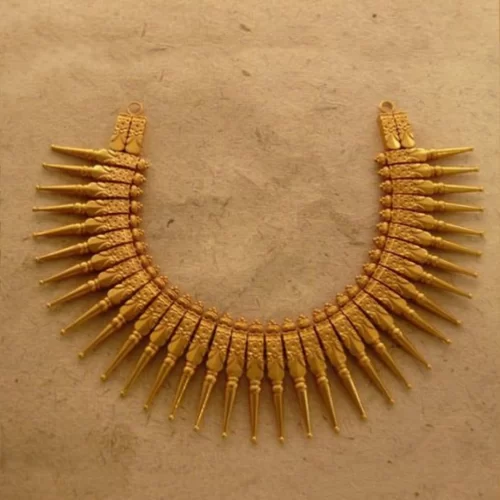
The necklace is typically composed of multiple chains of gold needles, ranging from 1 to 2 inches in length. These chains are connected by tiny gold beads, creating a cohesive and visually appealing piece. Soochi Mulla Mala can be worn as a standalone necklace or layered with other jewellery to create a more elaborate look.
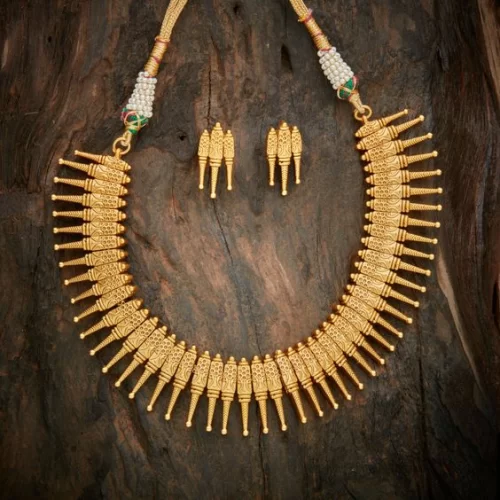
The origins of Soochi Mulla Mala can be traced back to the Malabar region of Kerala. The name “soochi” derives from the Malayalam word for “needle.” It is believed that the inspiration for this jewellery came from the needles used in the stitching of traditional Kerala attire.
Thoda Jewellery
Thoda jewellery is a traditional form of jewellery that is popular in certain regions of Kerala, India. It primarily consists of Thoda bangles and earrings, which are known for their unique design and craftsmanship.
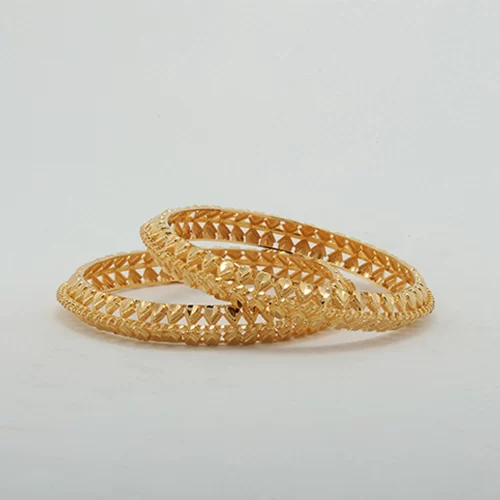
Thoda Bangles: Thoda bangles are a distinctive type of bangles that are crafted using intricate filigree work. They are typically made of gold and are characterized by their delicate and intricate patterns. The bangles are designed with precision, featuring fine details and motifs inspired by nature, such as flowers, leaves, and vines. Thoda bangles are often worn in pairs and are considered a symbol of femininity and grace. They are commonly adorned by women during weddings, festivals, and other special occasions in Kerala.
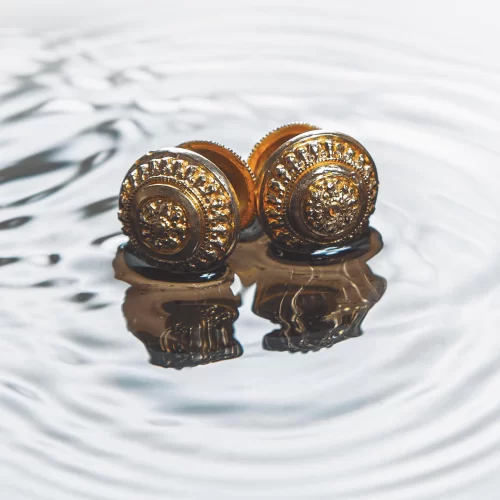
Thoda Earrings: Thoda earrings complement the beauty of the Thoda bangles and are crafted with similar filigree techniques. These earrings often feature intricate designs that match the patterns found on the bangles. They come in various styles, including studs, jhumkas (dangling earrings), and chandbalis (moon-shaped earrings). Thoda earrings are usually lightweight and comfortable to wear, making them suitable for both everyday wear and festive occasions.
The art of creating Thoda jewellery requires great skill and craftsmanship. Skilled artisans meticulously shape and mould thin gold wires to create the delicate filigree patterns seen in Thoda bangles and earrings. The process involves twisting and interweaving the wires to form intricate designs, resulting in a stunning piece of jewellery.
Jimikki
Jimikki, also known as jhumka, is a traditional and beloved earring style in Kerala and other parts of India. These bell-shaped earrings hold cultural significance and are commonly seen as a symbol of beauty and spirituality.
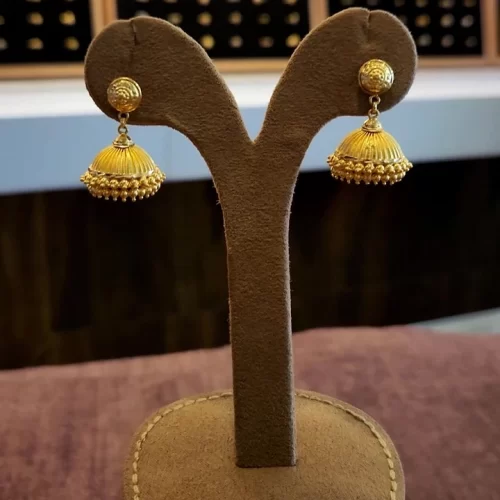
Jimikki earrings are characterized by their distinct bell shape, which resembles the traditional Indian jhumka or ghungroo (anklet bells). They are typically crafted from gold and adorned with intricate filigree work, floral motifs, and dangling gold beads. The delicate craftsmanship and attention to detail make Jimikki earrings a cherished accessory for women.
In Kerala, Jimikki earrings have a special place in bridal jewellery collections. They are often worn by brides on their wedding day, enhancing their beauty and completing their bridal look. These earrings add a touch of elegance and grace, reflecting the cultural heritage of the region.
Jimikki earrings are not only popular among brides but also widely worn by women across India. They come in various designs, sizes, and metal choices, allowing individuals to choose the style that resonates with their personal taste and style. Whether it’s a small and subtle jhumka or a larger, statement piece, Jimikki earrings are known for their versatility and ability to complement different outfits and occasions.
Adiyal Jewellery
In the realm of Keralan jewellery, one cannot overlook the allure of adiyal jewellery, particularly the exquisite adiyal necklace. Adiyal jewellery is deeply rooted in tradition and craftsmanship, showcasing intricate patterns and designs that have captivated the hearts of many.
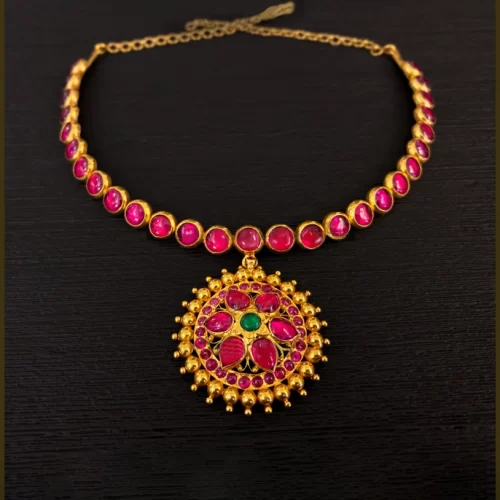
The adiyal necklace, the centerpiece of this style, holds a special place in Keralan adornment. Made from precious metals like gold or silver, this necklace is a symbol of elegance and grandeur. Its beauty lies not only in its materials but also in the craftsmanship that goes into its creation. Skilled artisans meticulously shape and mould the metal, creating intricate patterns and designs that evoke a sense of awe and admiration.
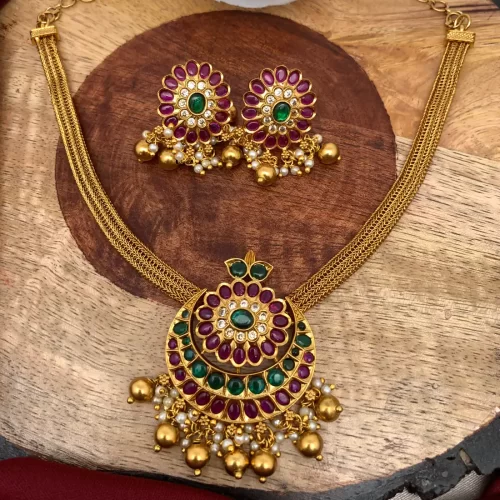
The designs of adiyal jewellery draw inspiration from the rich tapestry of Kerala’s culture and natural beauty. Floral motifs, leaves, and vines are commonly incorporated into the necklace, reflecting the lush flora that characterizes the region. Traditional Keralan symbols, such as the fish and the elephant, also find their place in the intricate patterns, infusing the jewellery with cultural significance and meaning.
Shankhu Mala
In the realm of Keralan jewellery, one cannot overlook the allure of adiyal jewellery, particularly the exquisite adiyal necklace. Adiyal jewellery is deeply rooted in tradition and craftsmanship, showcasing intricate patterns and designs that have captivated the hearts of many.
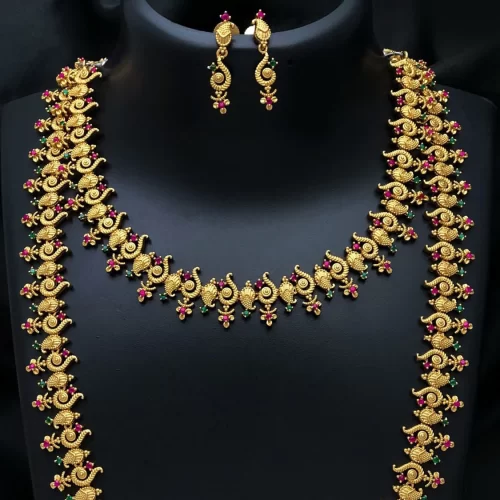
The adiyal necklace, the centerpiece of this style, holds a special place in Keralan adornment. Made from precious metals like gold or silver, this necklace is a symbol of elegance and grandeur. Its beauty lies not only in its materials but also in the craftsmanship that goes into its creation. Skilled artisans meticulously shape and mould the metal, creating intricate patterns and designs that evoke a sense of awe and admiration.

The designs of adiyal jewellery draw inspiration from the rich tapestry of Kerala’s culture and natural beauty. Floral motifs, leaves, and vines are commonly incorporated into the necklace, reflecting the lush flora that characterizes the region. Traditional Keralan symbols, such as the fish and the elephant, also find their place in the intricate patterns, infusing the jewellery with cultural significance and meaning.
Ilanji poo mala
The Ilanji Poo Mala is a stunning piece of fine jewellery that captures the essence of the Ilanji flower, also known as the Indian Cork Tree flower. This exquisite necklace is deeply rooted in South Indian culture and is treasured for its delicate beauty and symbolic significance.
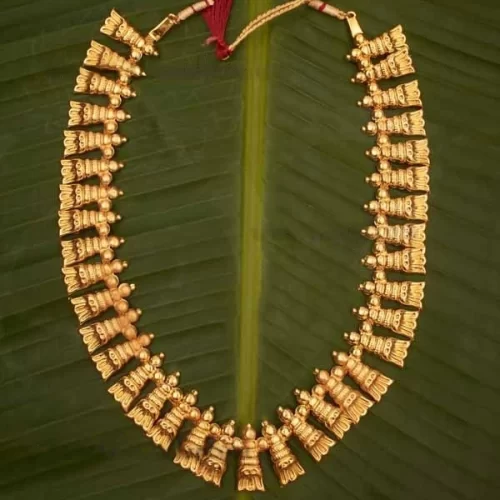
The Ilanji Poo Mala is meticulously crafted with precision and skill, showcasing the artistry of Indian jewellers. It is typically made from precious metals like gold and intricately designed to resemble the charming Ilanji flowers. Each flower is meticulously crafted with intricate detailing, capturing the essence of the natural bloom.
The Ilanji flower holds great cultural and emotional value in South India. It is revered for its enchanting fragrance and is often associated with love, purity, and devotion. The flower is considered sacred and is commonly used in religious ceremonies, auspicious occasions, and weddings.
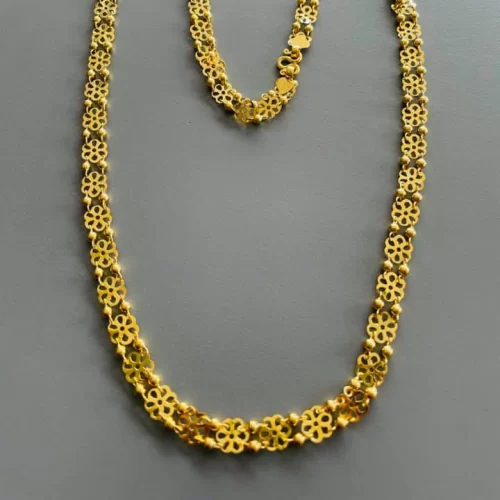
Wearing the Ilanji Poo Mala is believed to bring blessings of love, prosperity, and happiness. It is a symbol of purity and is often worn by brides as a representation of their new beginning and marital bliss. The delicate and elegant design of the necklace adds a touch of grace and charm to any attire, making it a cherished piece of fine jewellery.
Vilwadala Mal
Vilwadala Mala is an exquisite piece of fine jewellery that showcases the allure and beauty of traditional Indian craftsmanship. This intricately designed necklace captures the essence of the Vilwadala flower, also known as the Bael or Wood Apple flower, with its intricate patterns and elegant aesthetics.
The Vilwadala Mala is typically crafted using precious metals like gold and adorned with intricate detailing that mimics the delicate petals of the Vilwadala flower. The necklace is carefully handcrafted by skilled artisans, who bring their expertise and creativity to every piece, resulting in a masterpiece of fine jewellery.
The Vilwadala flower holds great significance in Indian culture and spirituality. It is considered sacred and is associated with Lord Shiva. The flower is often offered in temples and is believed to possess powerful medicinal and therapeutic properties. Its unique shape and fragrance have inspired artists and jewellery designers to create stunning pieces that pay homage to its natural beauty.
Veera Srunghala Bangle
Veera Srunghala Bangle is a captivating piece of fine jewellery that embodies strength, beauty, and elegance. This exquisitely crafted bangle showcases intricate detailing and impeccable craftsmanship, making it a true statement piece.
The Veera Srunghala Bangle draws inspiration from the majestic horns of the mythical creature Veera, symbolizing power and courage. The bangle is meticulously designed using precious metals like gold or silver and embellished with ornate patterns that mimic the graceful curves and contours of Veera’s horns.
Thechimottu mala
The Thechimottu Mala is an exquisite piece of fine jewellery that holds a special place in the rich cultural heritage of Kerala. This traditional necklace showcases the artistry and craftsmanship of skilled jewellery makers, making it a prized possession for those who appreciate its beauty and cultural significance.
The Thechimottu Mala is characterized by its intricate design, featuring delicate chains adorned with small gold beads that are linked together to form a stunning necklace. The word “thechimottu” in Malayalam translates to “honey drop,” which perfectly captures the visual allure of this necklace. The intricate patterns and careful arrangement of the golden beads resemble glistening droplets of honey, creating a mesmerizing effect.
Crafted using precious metals like gold, the Thechimottu Mala is a symbol of luxury, elegance, and tradition. The necklace is meticulously handmade, with each bead and link thoughtfully arranged to create a harmonious and visually striking piece. It showcases the craftsmanship and attention to detail that are hallmarks of fine jewellery.
The Thechimottu Mala holds a special place in traditional Keralan weddings and festive occasions. It is often worn by brides as part of their bridal ensemble, adding a touch of opulence and grandeur to their attire. The necklace beautifully complements traditional Keralan saris and is adorned with other traditional jewellery pieces, enhancing the overall beauty of the bride.
Gundla Mala
The Gundla Mala necklace is a stunning example of traditional Indian beaded jewellery that comes in a wide range of designs and styles. This necklace style is particularly popular in South India and has gained popularity throughout the country, especially with the emerging trend of layered necklaces. The Gundla Mala necklace is characterized by its unique design, featuring a series of intricately arranged beads that come together to form a striking and elegant piece of jewellery.
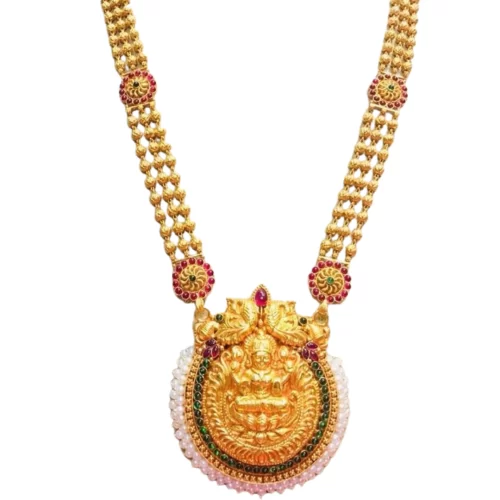
The beads used in the necklace can vary in size, shape, and colour, offering a wide range of options to suit individual preferences and styles. Some Gundla Mala necklaces also incorporate precious gemstones or enamel work, adding a touch of luxury and glamour.

When choosing a Gundla Mala necklace, it is important to consider the quality and craftsmanship of the piece. Look for reputable jewellers who specialize in traditional Indian jewellery to ensure you are acquiring an authentic and well-crafted necklace. Each Gundla Mala necklace is a unique work of art, and investing in a high-quality piece ensures its longevity and enduring beauty.
Dalamini Necklace
The Dalamini necklace is a captivating piece of traditional Keralan jewellery that holds both aesthetic and symbolic significance. Crafted with meticulous attention to detail, this necklace showcases the artistry and craftsmanship that is synonymous with fine jewellery from Kerala. One of the distinguishing features of the Dalamini necklace is the presence of moonstones.
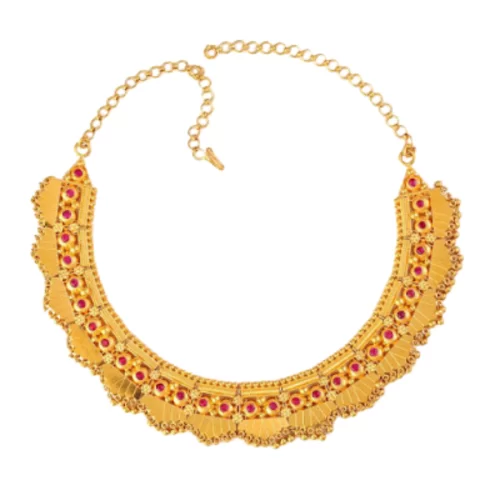
Moonstone is a semi-precious gemstone known for its ethereal beauty and iridescent glow. The necklace is often embellished with carefully selected moonstones, which enhance its allure and lend it a sense of mystique. Moonstones are believed to possess healing and calming properties and are associated with good luck and prosperity in Keralan culture.

The Dalamini necklace is often worn on special occasions and festivals, where it adds a touch of elegance and grace to the wearer’s ensemble. It complements traditional Keralan attire, such as sarees and lehengas, beautifully enhancing the overall look. The necklace can also be paired with other pieces of jewellery, such as earrings and bangles, to create a coordinated and exquisite ensemble.
Lolakku jewellery
Lolakku jewellery, also known as Lolakku earrings, is a type of traditional Indian jewellery that has recently made a comeback in fashion trends. These danglers were particularly popular in the late 1970s and early 1980s and are now regaining their popularity due to their unique design and timeless appeal.
The distinctive feature of Lolakku jewellery is the exquisitely carved grooves on the earrings, which create a beautiful play of light and shadows, resulting in a shimmering effect. These intricate carvings add a touch of elegance and sophistication to the earrings, making them stand out as statement pieces of jewellery.
The shimmering effect of Lolakku earrings makes them a versatile choice for various occasions. They can be worn with both traditional and contemporary outfits, adding a touch of glamour and sophistication to any ensemble. Whether it’s a festive celebration, a wedding, or a special event, Lolakku earrings are sure to make a statement and draw attention with their unique design and eye-catching shimmer.
Thadavala and Ottavala
In Kerala, the tradition of adorning the wrists with multiple bangles is deeply rooted in the culture, especially for brides. Among the assortment of bangles worn by Malayali brides, two prominent styles are the “thadavala” and “ottavala” bangles.
Thadavala bangles, also known as kada bangles, are thick and sturdy bracelets that often flank the various other bangle designs adorning the bride’s forearm. These bangles come in various styles and finishes. Some thadavala bangles are round and thick with a simple plain finish, while others are broader and flat with intricate patterns and designs etched into them. They are typically made of gold or other precious metals and are cherished for their traditional appeal and elegance.
On the other hand, ottavala bangles are thinner and more delicate compared to thadavala bangles. They are often worn alongside thadavala bangles in a pattern that creates a beautiful contrast on the bride’s wrist. Ottavala bangles may feature more intricate designs, including motifs, filigree work, or even gemstone embellishments. These bangles are typically worn in multiples to create a stunning visual effect.
Karavala
Karavala fine jewellery is a traditional style of jewellery that is popular in Kerala, India. The term “karavala” refers to the shape of the jewellery, which resembles the shape of a twisted rope or a snake. It is typically made from gold or silver and is known for its intricate designs and craftsmanship.
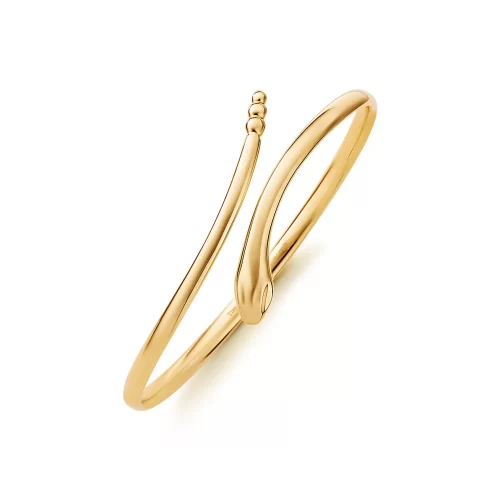
Karavala jewellery is often worn by women during special occasions and festivals, such as weddings and religious ceremonies. It is believed to bring good luck and prosperity to the wearer. The twisted rope design of the jewellery symbolizes strength and unity.
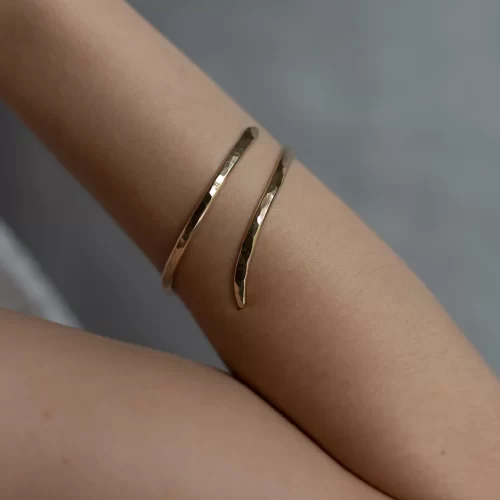
Karavala jewellery comes in various forms, including necklaces, earrings, bracelets, and bangles. Each piece is unique and carries the rich cultural heritage of Kerala. The intricate designs and attention to detail make Karavala jewellery a timeless and cherished accessory for women in Kerala.
Mookuthi
Mookuthi, also known as nose rings or nose studs, hold great significance in Indian culture and weddings. They have evolved from being mere decorative accessories to symbols of social status and tradition. Nose rings come in various metals, stones, and styles, with gold and simple diamond studs being particularly popular.

Traditionally, the mookuthi is worn by married women, signifying their marital status. It holds deep cultural and social significance, symbolizing a woman’s commitment to her husband and family. In addition to its symbolic meaning, there are beliefs that nose piercing and wearing a nose ring can have positive effects on a woman’s reproductive organs and even help reduce the pain of childbirth.

The mookuthi is typically simple in design, with a single diamond stud being the most common choice. However, there are also elaborate designs available, featuring intricate patterns, gemstones, and enamel work. The choice of design often depends on personal preference, cultural traditions, and the occasion.
Nettichutti
A Nettichutti, also known as Nethi Chutti or Nethichutti, is a traditional bridal accessory that holds immense significance in South Indian weddings, particularly among Nair brides. Similar to a maang tikka or a matha patti, the Nettichutti is worn on the forehead and adds a touch of elegance and regality to the bride’s overall look.
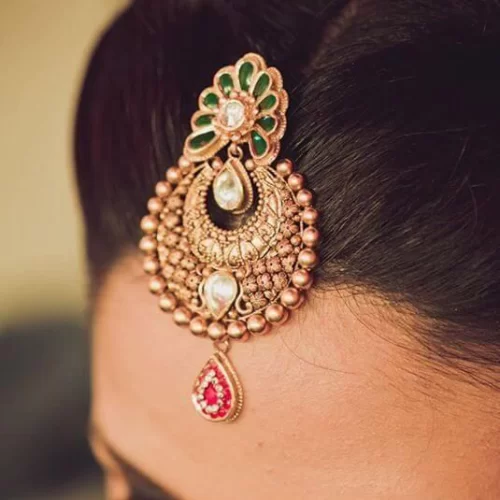
Typically, a Nettichutti consists of a long gold chain that rests along the hairline, with a decorative pendant or locket dangling at the end. The pendant is often adorned with colorful gemstones, intricate designs, and sometimes pearls, adding a vibrant and luxurious touch to the piece.
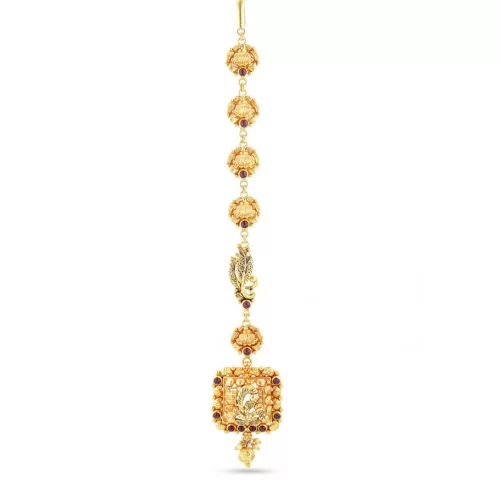
The placement of the Nettichutti on the forehead is associated with the bride’s third eye or ajna chakra, representing intuition, wisdom, and spiritual awakening. The design of the Nettichutti may vary based on regional customs and personal preferences. Some brides opt for more elaborate and intricate designs, while others prefer simpler and minimalist styles. It is also common to see variations in the materials used, with options ranging from traditional gold to contemporary designs featuring gemstones, pearls, and enamel work.
Oddiyanam
Oddiyanam, also known as Vaddanam or Hip chain, is a stunning and ornate waist belt-like piece of jewellery that is traditionally worn by women, particularly during weddings and special occasions in South India. It is an essential part of the bridal ensemble and is designed to accentuate the bride’s slender figure while adding a touch of elegance and grandeur to her overall look.

The Oddiyanam comes in various types, designs, and materials, offering a wide range of choices for brides to match their personal style and preferences. Some popular types include diamond Oddiyanam, temple or kemp Oddiyanam, gold Oddiyanam, and modern Oddiyanam, among others. Each type showcases unique craftsmanship and artistry, making it a significant and eye-catching piece of jewellery.

Traditional Oddiyanams often feature intricate designs depicting Indian gods and goddesses or popular motifs like manga (mango) design, symbolizing fertility and prosperity. These designs are meticulously crafted, showcasing the rich cultural heritage and traditional art forms of South India.
On the other hand, modern Oddiyanams exhibit contemporary designs using precious gemstones like diamonds, emeralds, rubies, and other expensive stones. These designs offer a fusion of traditional and modern elements, catering to the evolving preferences of brides and adding a touch of glamour to their attire.
Arapatta
Arapatta jewellery, specifically the Arapatta waist chain, is a traditional Indian accessory that holds a significant place in Indian culture and history. Also known as ‘kamarband’ or ‘udyanam’, the Arapatta waist chain is worn around the waist and is typically made of gold or silver.
The Arapatta waist chain has a rich heritage that dates back thousands of years. It finds its roots in ancient Indian traditions and is associated with various cultural and social practices. In ancient times, waist chains were believed to possess mystical and therapeutic properties, promoting good health and well-being. They were also seen as a symbol of prosperity and affluence.
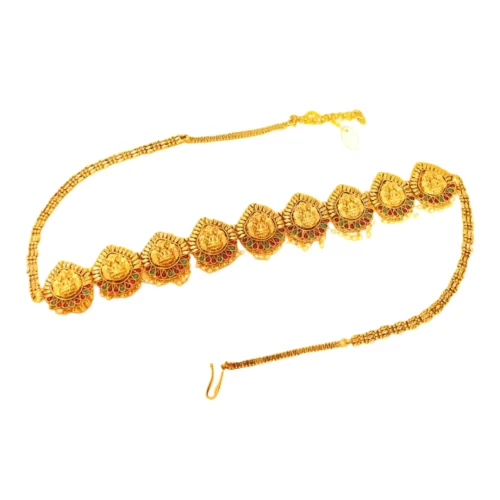
Historically, the Arapatta waist chain was adorned by both men and women, particularly in royal families and among the elite. It was considered a symbol of power, wealth, and social status. The intricate designs and craftsmanship of these waist chains reflected the opulence and grandeur of the era.
In contemporary times, the Arapatta waist chain has evolved as a fashionable accessory, worn primarily by women. It is now popularly worn during weddings, festivals, and other special occasions. The waist chain adds a touch of elegance and charm to the attire, enhancing the overall look of the wearer.

Arapatta waist chains come in a variety of designs, ranging from simple and delicate chains to more elaborate and ornate ones. They may feature intricate patterns, motifs inspired by nature, or religious symbols. Some waist chains may also incorporate precious gemstones or enamel work to enhance their beauty.
Mekka mothiram
Mekka mothiram is a unique and traditional earring worn by elderly women in certain communities, particularly among Christian women in Kerala, India. It is a distinct style of earring that is known for its elongated hoop shape and is typically worn on the upper part of the earlobe.

Christian women in Kerala often wear their traditional attire, which includes the chatta (blouse), mundu (wrap-around skirt), kavini (shawl), and mekka mothiram as part of their cultural and religious practices. These earrings hold cultural and sentimental value, often passed down through generations.
The mekka mothiram earring is a symbol of tradition and heritage. Its design can vary, but it typically consists of a hoop that is elongated and slender, sometimes adorned with intricate patterns or small dangling elements. The earring is made of precious metals like gold or silver and may be embellished with gemstones or enamel work for added beauty.
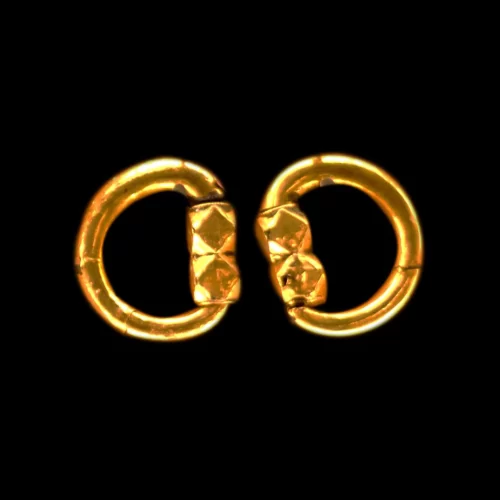
One significant occasion where the mekka mothiram is prominently worn is during the performance of Margam Kali, a traditional dance form in Kerala. Margam Kali involves a group of women performing rhythmic steps while singing traditional songs. The dancers often wear vibrant costumes and accessories, including the mekka mothiram earrings, which add to the overall visual appeal of the performance.
The mekka mothiram earrings hold cultural and sentimental value, representing the rich traditions and customs of the community. They are considered a symbol of respect and honour for elderly women and are worn with pride. These earrings not only enhance the beauty of the wearer but also serve as a reminder of their cultural identity and heritage.
Kolusu
A “Kolusu” also known as Padasaram, is a type of anklet that is commonly worn by girls and women in Kerala during weddings, religious ceremonies, and festive occasions. The Kolusu is an important accessory that adds beauty and charm to the feet of the wearer. Traditionally, Kolusus were made of silver, and they are still predominantly crafted from this metal. The anklets feature intricate designs and patterns, including floral motifs, geometric shapes, and traditional symbols. The silver anklets are often adorned with tiny bells that produce a pleasant tinkling sound when the wearer walks or moves, adding a musical element to their appearance.
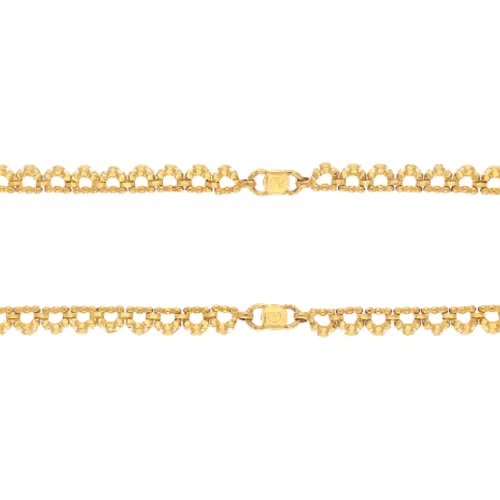
In addition to silver, Kolusus are also available in gold. Gold Kolusus are considered more ornate and luxurious, often featuring elaborate designs and embellishments. They may be studded with gemstones, such as diamonds, rubies, or emeralds, to enhance their beauty and value.
Kolusus are typically worn in pairs, one on each ankle. They are secured around the ankle with a chain or a clasp, ensuring a comfortable fit. The length and thickness of the anklet can vary based on personal preference and style.
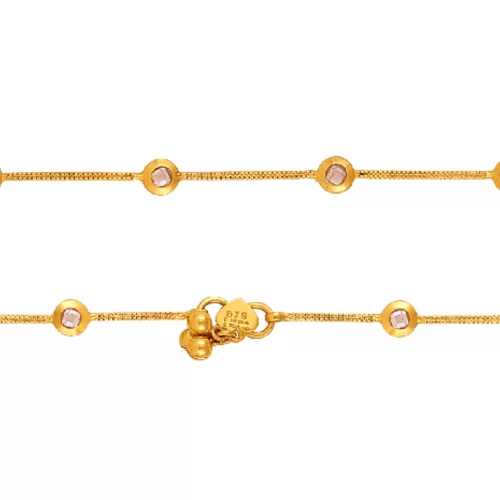
Apart from their aesthetic appeal, Kolusus hold cultural and traditional significance in Kerala. They are believed to bring good luck and prosperity to the wearer. The tinkling sound produced by the bells is thought to ward off evil spirits and attract positive energy.
Kolusus are not limited to specific age groups and are worn by girls, young women, and married women alike. They are an integral part of the traditional attire in Kerala, complementing various outfits such as sarees, lehengas, and other ethnic wear.
In recent times, Kolusus have also evolved to include modern designs and materials, catering to contemporary fashion trends. They may incorporate elements like beads, charms, and even synthetic materials. This diversity allows individuals to choose Padasaram that suits their personal style and preferences.
Kettarimbu
Kettarimbu is a traditional gold ornament that holds a special place in the Namboodiri community of Kerala. Known for its exquisite craftsmanship and intricate designs, the Kettarimbu showcases the rich cultural heritage of the region.
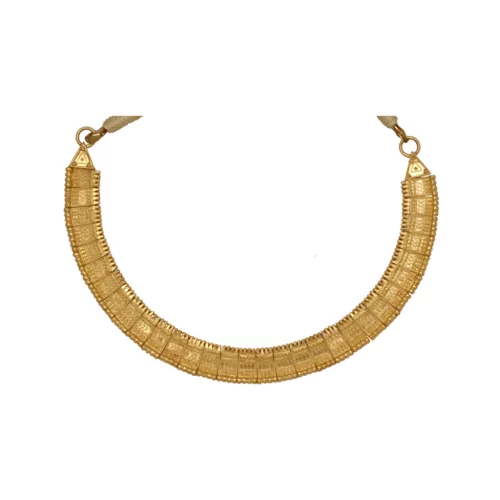
The Kettarimbu is characterized by its unique features and attention to detail. The ornament is crafted in the shape of a small choker, typically adorned with miniature floral motifs and embossed geometrical patterns. The top and bottom of the pendant often feature arimbu work, a technique that involves delicate filigree or granulation work.

The craftsmanship of the Kettarimbu is truly remarkable. Skilled artisans meticulously create each piece, ensuring precision in every detail. The floral designs are intricately carved, while the geometric shapes are perfectly incorporated into the overall composition. The arimbu work adds a touch of elegance and sophistication to the ornament, making it a true symbol of perfection.
Manomani mala
The Manonmani necklace is a traditional and exquisite piece of jewellery that showcases the skill and artistry of traditional goldsmiths. This long-forgotten necklace has been revived to bring its beauty and intricacy back to life.
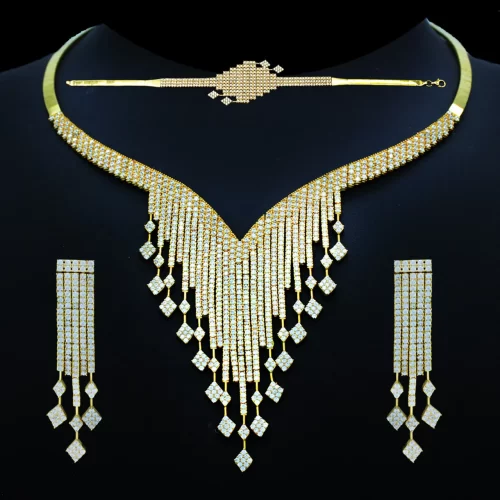
Crafting the Manonmani necklace requires hours of painstaking work and dedication. Each of the long grain-shaped units (“nellu”) is meticulously fused together to create a stunning piece of jewellery. The craftsmanship involved in its creation is a true testament to the expertise and talent of traditional goldsmiths.
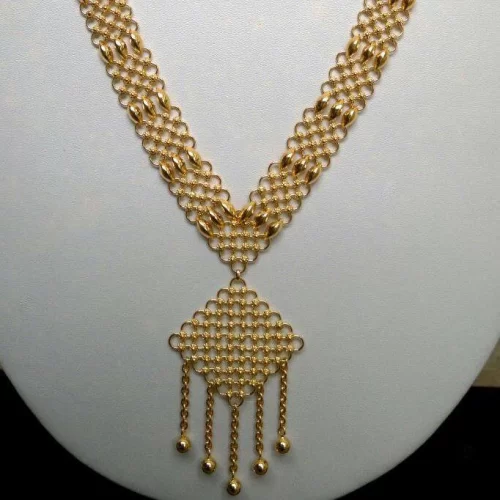
The Manonmani necklace features elongated gold beads and links that are intricately intertwined to create a lace-like effect. The design snugly fits the contours of the neck, enhancing the wearer’s elegance and beauty. The necklace is designed in a traditional long-chain style, with long grain-shaped units interlinked with delicate circular links, resulting in a mesmerizing lace-like pattern in gold.
Pookula mala
The Pookula Mala is a unique and distinct piece of jewellery that is synonymous with the beauty and essence of Kerala. It is inspired by the swaying coconut palms that form the green canopy of Kerala’s landscape, symbolizing the lushness and vibrancy of the region.
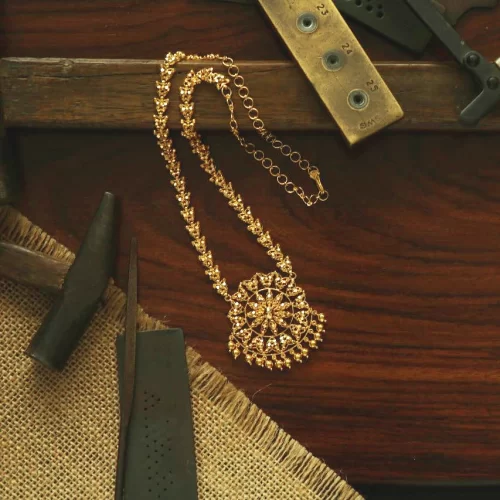
The Pookula Mala celebrates the delicate and golden-coloured coconut flower, known as “pookkula” in Malayalam. This flower holds cultural significance in Kerala and is often used in religious rituals and ceremonies. The necklace replicates the upward curve of the coconut flower’s stem, known as “kathir,” and features a matching pendant that adds to its elegance.
This piece of jewellery is characterized by its lightness and unique design.
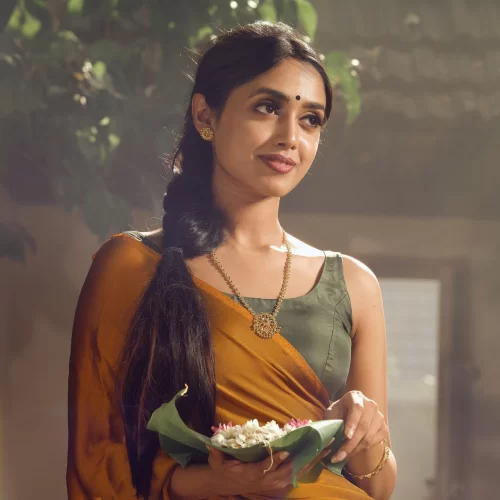
It stands out for its simplicity and the intricate craftsmanship that goes into creating it. The Pookula Mala captures the natural beauty of Kerala’s landscape and the cultural importance of the coconut tree in the lives of its people.
Vairaminni Mala
The Pookula Mala is a unique and distinct piece of jewellery that is synonymous with the beauty and essence of Kerala. It is inspired by the swaying coconut palms that form the green canopy of Kerala’s landscape, symbolizing the lushness and vibrancy of the region.
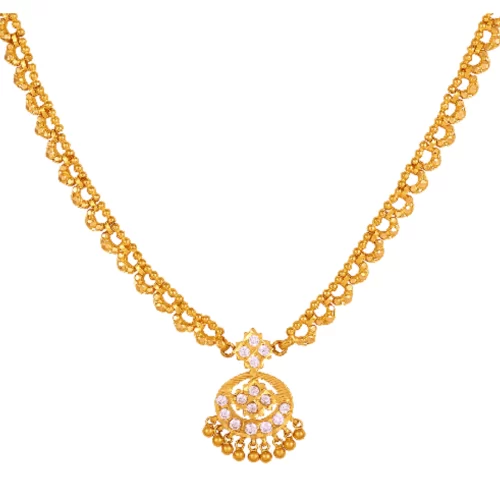
The Pookula Mala celebrates the delicate and golden-coloured coconut flower, known as “pookkula” in Malayalam. This flower holds cultural significance in Kerala and is often used in religious rituals and ceremonies. The necklace replicates the upward curve of the coconut flower’s stem, known as “kathir,” and features a matching pendant that adds to its elegance.
This piece of jewellery is characterized by its lightness and unique design.
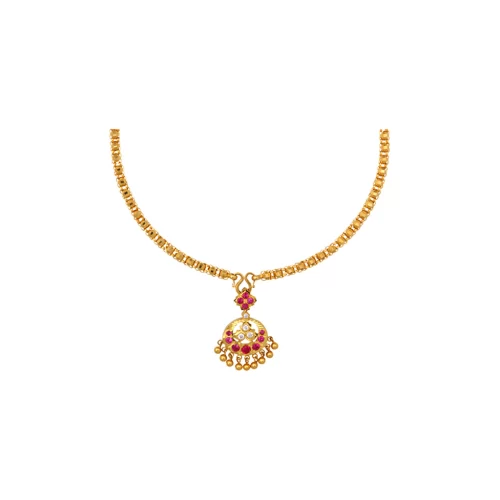
It stands out for its simplicity and the intricate craftsmanship that goes into creating it. The Pookula Mala captures the natural beauty of Kerala’s landscape and the cultural importance of the coconut tree in the lives of its people.
Panamala
The Panamala is a long chain necklace that exudes simplicity and elegance. Its design features superbly polished gold discs that are attached with delicate gold beads and links. This classic piece of jewellery complements any Indian attire, adding a touch of sophistication to the overall look.
The name “Panamala” is derived from the word “Panam,” which translates to coins or currency. The necklace is reminiscent of the traditional currency used in ancient times. The gold discs, resembling coins, are strung together with precision, creating a mesmerizing effect as they catch the light with every movement. The high polish of the discs adds a lustrous gleam to the necklace, enhancing its visual appeal.
The Panamala is also known as Pavan Sara in Karnataka, where coin-shaped trinkets are arranged in a regular pattern to form the necklace. The necklace holds cultural significance and is cherished by Kannadiga brides and women. Over time, modern variations and arrangements of the Panamala have emerged, allowing individuals to choose from a range of patterns and styles while still appreciating the traditional beauty of the Pavan Sara.
Thirumangalyam or Thali
The Thirumangalyam, also known as “Thali” or “Mangalsutra,” is a highly symbolic and significant piece of bridal jewellery in many South Asian cultures, particularly in India. It holds immense cultural and emotional significance in Hindu weddings.
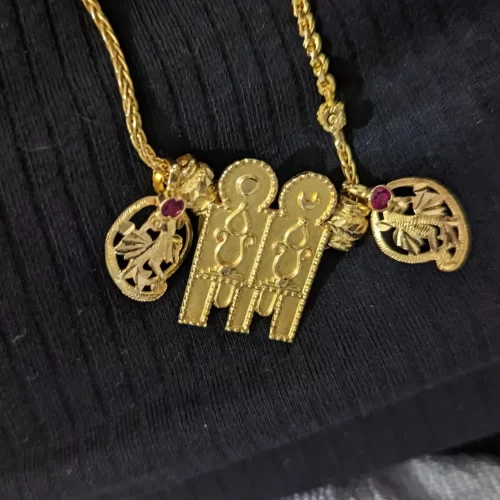
The Thirumangalyam is a pendant or a leaf-shaped ornament that is tied around the bride’s neck by her groom during the wedding ceremony. It is a sacred thread or necklace that represents the marital bond and signifies the commitment and love between the husband and wife. The groom’s act of fastening the Thirumangalyam around the bride’s neck is a ritual known as “Tying the Knot” or “Mangalya Dharanam.”One of the most popular designs for the Thirumanglayam in Kerala is the Kumbla Thali.
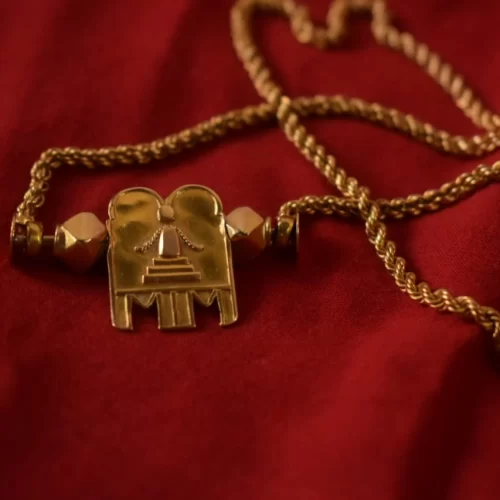
The Thirumangalyam is typically made of gold and may be embellished with intricate designs or patterns. The pendant is often adorned with symbols of cultural and religious significance, such as the image of deities or auspicious motifs like the sun, moon, or conch shell.
This piece of jewellery holds deep symbolism and serves as a visible symbol of a married woman. It signifies the husband’s respect and commitment towards his wife and the sanctity of their union. It also represents the dignity and honour of the wife’s role in the family and society.
Kurumulaku Mala
The Kurumulaku Mala is a traditional Indian wedding jewellery piece that is popular in some regions of South India. It is a necklace made of small, closely fused gold beads, giving it a unique texture and appearance. The name “Kurumulaku” translates to “black pepper” in English, referring to the small and closely arranged beads resembling the appearance of pepper grains.
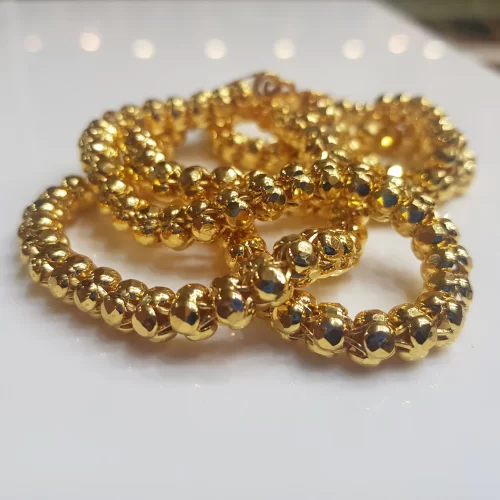
The necklace typically features a statement locket or pendant in the centre, which adds to its overall design and serves as a focal point. The locket may be adorned with intricate patterns, gemstones, or religious symbols, depending on personal preferences and cultural traditions.
The Kurumulaku Mala is often worn by brides as part of their wedding jewellery ensemble.

It is usually layered with other necklaces of varying lengths, creating a cascading effect and adding to the overall ornate look. The necklace sits prominently in the middle of the other necklaces, drawing attention to its distinctive design and craftsmanship.
Jhoomar
The Jhoomar, also known as Passa or Side Tikka, is a hair ornament traditionally worn by Indian brides, particularly in Punjab and found its way all the way to some parts of Kerala. It is a popular accessory for head and hair decoration. The Jhoomar has its origins in Mughal-inspired jewellery and is often adorned with pearls, gemstones, and intricate designs.
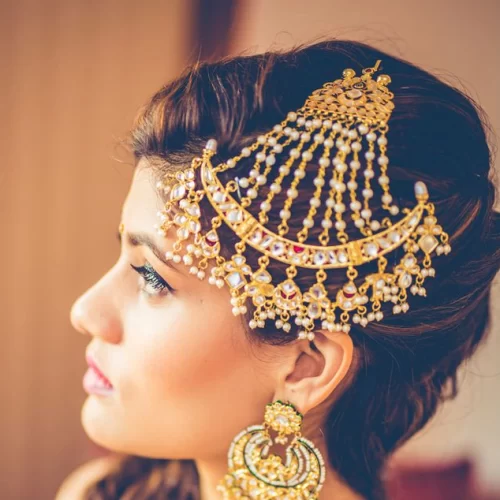
The Jhoomar is typically worn on the left side of the head and is placed in the hair during the bridal ceremony. It adds a touch of elegance and charm to the bride’s overall look. In some cases, the bride may choose to wear a Jhoomar instead of the traditional Nettipattam, the Nettipattam is crafted from gold which rests on the bride’s forehead like a maang tikka, and is pleasantly engraved with intricate designs and encrusted with glimmering precious gemstones.

The design of the Jhoomar features a crescent moon shape, which is a symbol with Islamic significance. The crescent moon holds religious and cultural symbolism in Islamic traditions, and it is considered auspicious. The Jhoomar incorporates this crescent shape, often adorned with diamonds, rubies, emeralds, and pearls.
Hathphool
Hathphool is a bracelet-like jewellery piece that extends from the wrist to the fingers, covering the back of the hand. It is traditionally worn by Indian brides as part of their bridal ensemble, particularly with traditional Indian lehengas. Hathphools are designed to enhance the overall look of the bride’s hands.
The name “Hathphool” translates to “flower of the hand,” and the jewellery itself is often crafted with intricate artistry. While golden Hathphools were popular in the past, modern variations have emerged using different materials and designs.
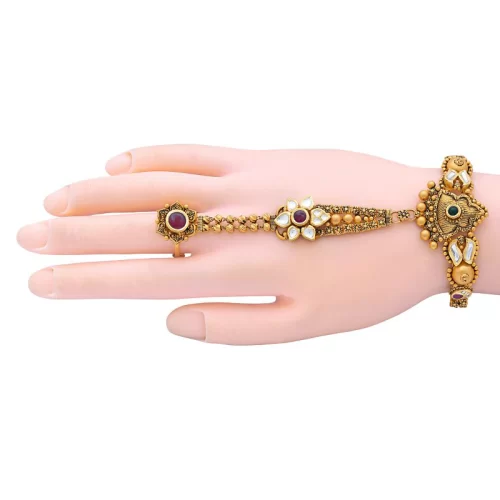
Originally, it was believed that Hathphools were exclusively made with kundan or jadau, which are traditional Indian jewellery techniques. However, contrary to this belief, Hathphools can be made using gold, silver, uncut stones, diamonds, and other materials. They have a historical significance and were popular during the Mughal era. In fact, they were also worn by Persian dancers of that time.
A typical Hathphool consists of eight rings (excluding the thumbs) that are worn on both hands. These rings are connected to a central floral adornment on the upper part of the hand and further linked to a beautiful wrist bangle. The jewellery piece also includes a dangling chain that extends behind both hands. Each chain symbolizes the power of the goddess and is believed to provide protection to the bride.
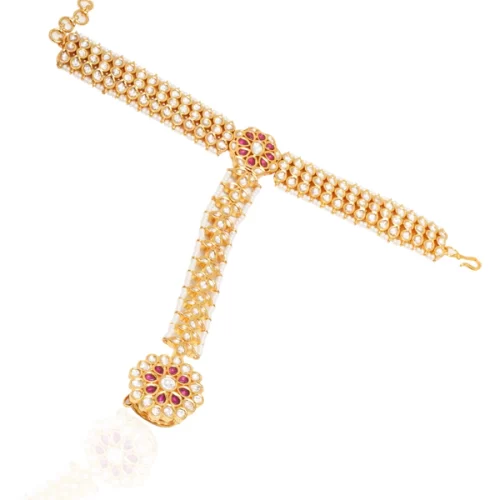
According to ancient sciences, Hathphools are considered perfect tools for recharging the body’s energy. They press against various nerves on the wrist and fingers, and their round shape ensures the transfer of energy back to the wearer. Despite the trend of minimalistic jewellery, the traditional Hathphool has found contemporary stylizations that keep the focus on the bridal hands.
Pappadathali
Pappadathali is a necklace that derives its name from the pappadam-shaped locket it features. The locket resembles a pappadam, a thin and crispy Indian flatbread. This unique design adds a playful and quirky element to the necklace.
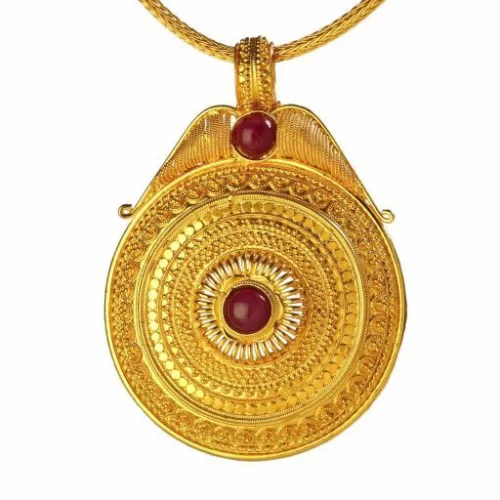
The pappadathali typically consists of a chain that is attached to the pappadam-shaped locket. The locket can be made of various materials, such as gold, silver, or even artificial materials, depending on personal preference and affordability. The locket is often small in size, resembling the shape and texture of a pappadam.

One distinctive feature of the pappadathali is the small stone placed in the middle of the locket. This stone comes in different colour choices, allowing individuals to personalize their necklace according to their taste and style. The stone adds a pop of colour and enhances the visual appeal of the locket.
Kanakamala Necklace
The Kanakamala Necklace is a traditional Indian jewellery piece known for its intricate drop pendant design. The pendant typically features a burst of bright flowers suspended from a colourful crest.
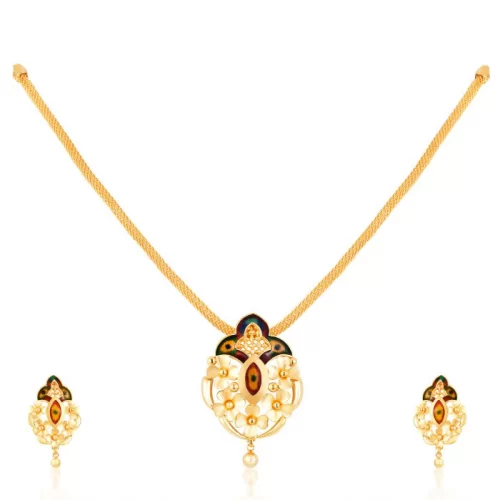
It is a versatile necklace that can be worn with a variety of ethnic Indian outfits, ranging from casual to semi-formal attire.
The pendant of the Kanakamala Necklace is crafted with attention to detail and often showcases delicate floral patterns or motifs.

The use of vibrant colours adds a lively and festive touch to the necklace, making it suitable for various occasions. The pendant may be made of gold, silver, or other metals and can be adorned with gemstones, beads, or enamel work to enhance its beauty.
Gaja Mala
Gaja Mala is a type of Indian necklace that features motifs of elephant heads. The term “Gaja” translates to “elephant” in Sanskrit. Gaja Mala is known for its distinct design, where elephant head motifs are incorporated into the necklace in a repetitive pattern.
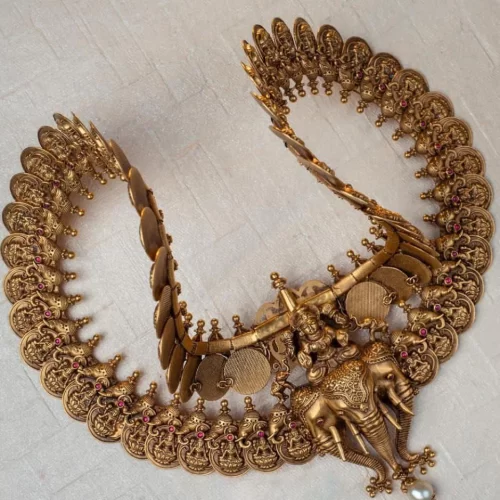
The elephant is considered a sacred animal in many Indian cultures and symbolizes strength, wisdom, and prosperity. In the Gaja Mala, the elephant head motifs are often intricately designed and crafted, capturing the majestic and regal nature of these animals.
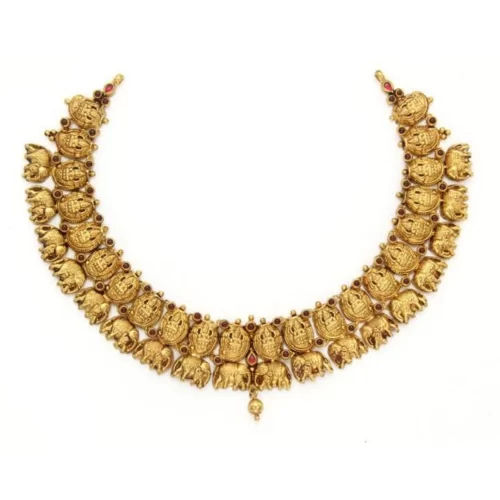
Gaja Malas are typically long chains that can be worn as standalone necklaces or layered with other jewellery pieces. They are commonly made of gold, although variations with silver or other metals are also available. The elephant head motifs may be adorned with gemstones, enamel work, or other decorative elements to enhance their appearance.
Vanki
The Vanki, also known as Aaram, is an armlet worn mostly by Hindus, particularly in the state of Kerala in South India. It is a traditional piece of jewellery that is not very common but holds cultural and aesthetic significance. The Vanki is typically made of gold and features intricate designs and embellishments.
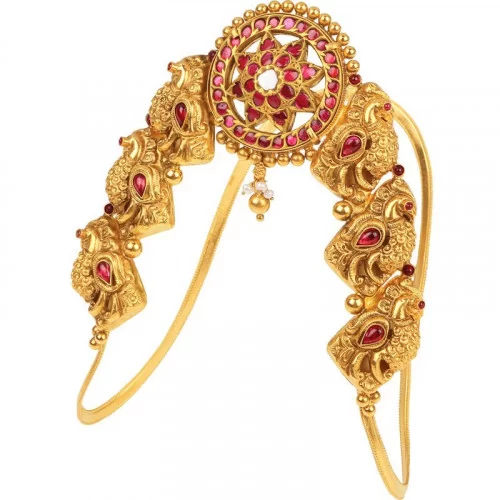
The Vanki has an inverted “V” shape and is worn on the upper arm. It is known for its distinctive design, which often includes motifs of serpents, Hindu deities, or other traditional patterns. The armlet is adorned with coloured gemstones, such as rose-cut diamonds, rubies, and emeralds, to enhance its beauty and elegance.

The Vanki is crafted with precision and attention to detail, reflecting the craftsmanship of skilled artisans. The design of the Vanki often resembles the petals of a lotus flower, adding a touch of natural beauty to the piece. It is available in various style variations, but the most prized ones feature deity figures adorned with precious gemstones, symbolizing divine blessings and protection.
Navaratna Jewellery
Navaratna is a term used to describe a talisman, piece of jewellery, or ornament composed of nine perfect gemstones. Navaratna jewellery is created using all nine stones, and each stone represents a specific planetary body and taps into its energies. These gemstones are considered sacred and are associated with moon signs rather than sun signs, making them different from birthstones.

In Navaratna jewellery, the central stone is typically a Ruby, representing the sun, and it is encircled by the other eight gemstones. Here is a list of the gemstones and the planets they represent:
- Ruby (Maanik/Maanikkam) – Represents the Sun
- Diamond (Heera/Vairam) – Represents Venus
- Emerald (Panna/Marakadham) – Represents Mercury
- Yellow Sapphire (Pukharaj/Kanagapushparagam) – Represents Jupiter
- Cat’s Eye (Lehsuniya/Vaiduryam) – Represents Ketu (the moon’s descending node)
- Blue Sapphire (Neelam) – Represents Saturn
- Hessonite (Gomedh/Gomedhakkam) – Represents Rahu (the moon’s ascending node)
- Coral (Moonga/pavazham) – Represents Mars
- Pearl (moti/Muthu) – Represents the Moon
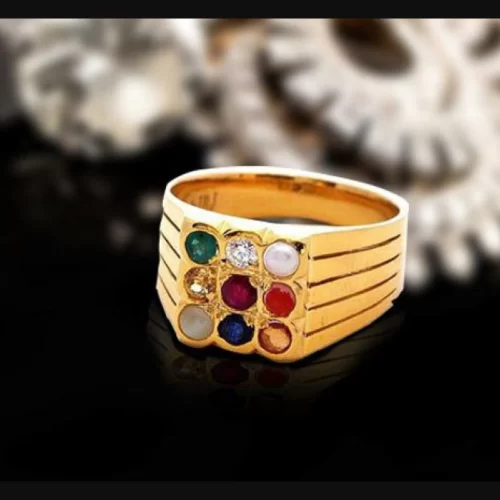
Navaratna jewellery is believed to harness the energies of these planetary bodies and bring positive influences to the wearer. It is popularly worn in the form of rings and bangles. In Kerala, Navaratna jewellery, particularly rings and bangles, are widely cherished and admired for their beauty and spiritual significance.
Polki Jewellery
Polki jewellery, known for its exquisite design using uncut diamonds, has its origins in the ancient Mughal period. The artistry and craftsmanship of Polki have remained consistent over the years. Uncut diamonds are carefully arranged and set within gold boundaries, resulting in a symmetrical and stunning jewellery piece. Unlike processed diamonds, Polki diamonds retain their raw form, giving them a distinct rustic and indie look that embodies the essence of Indian jewellery.
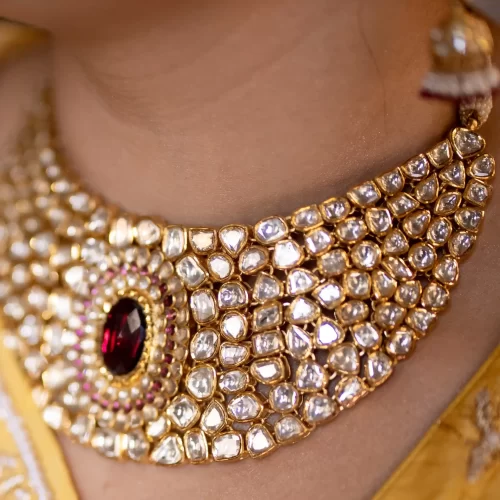
Polki jewellery is highly valued and often comes with a higher price tag due to its unique characteristics and craftsmanship. One way to differentiate Polki from Kundan jewellery is by examining the shape of the stones. Polki stones are typically curved or slightly convex, showcasing their authentic and natural appearance.
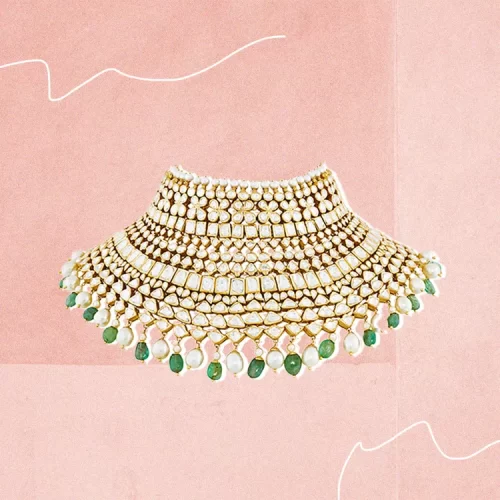
While Polki jewellery originated with the Mughals, it has gained popularity throughout India, including in the state of Kerala. Although not traditionally associated with Kerala’s jewellery repertoire, Polki jewellery has found its way into the region through various channels. With the expansion of trade networks and cultural exchanges, Polki Jewellery has made its presence felt in different parts of the country, including Kerala.
Kundan Jewellery
Kundan jewellery, with its shimmering and classy appearance, has found its way into Kerala through a combination of cultural influences and trade networks. Derived from Polki jewellery, Kundan jewellery features glass stones that emulate the look of diamonds, exuding a sense of generosity and royalty. It is a result of the fusion between the traditional Mughal jewellery and the intricate craftsmanship of Rajasthan.

The artistry of Kundan jewellery lies in its structured design, created by setting the glass stones within gold or silver boundaries. The use of glass stones instead of diamonds makes Kundan jewellery more affordable compared to Polki. The sparkling shine of Kundan jewellery sets it apart from the rustic look of Polki. The intricate detailing of Kundan jewellery showcases its elegance and craftsmanship.

To distinguish between Polki and Kundan jewellery, several factors can be observed. Polki jewellery is characterized by its rustic appearance, while Kundan jewellery sparkles with a shiny radiance. Polki jewellery is crafted using uncut diamonds, while Kundan jewellery utilizes glass stones. Additionally, Polki jewellery often features a colourful meenakari design on the back of the necklace, which is not typically seen in Kundan jewellery.
Attigai Jewellery
Attigai jewellery is a traditional necklace that holds great significance among Tamilian women. Known for their rich and ornate appearance, Attigai necklaces are adorned with red and green stones, lending a vibrant and opulent touch to the wearer’s ensemble. These necklaces are highly sought after for their intricate designs and timeless beauty.
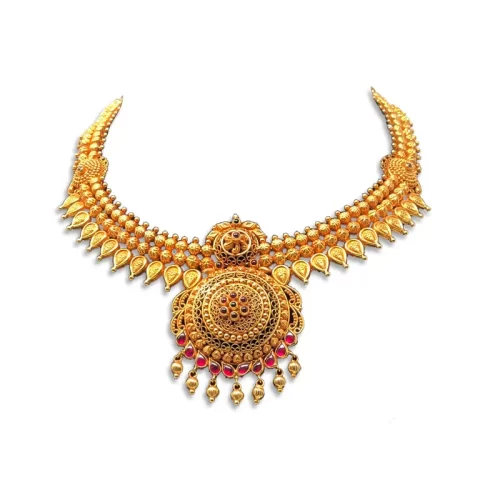
The word “Attigai” translates to “necklace” in Tamil, and it is an integral part of the cultural heritage of Tamil Nadu. The necklaces typically feature a series of linked gold or silver beads, embellished with precious gemstones such as rubies, emeralds, or green and red stones. The arrangement of these stones creates a striking contrast against the gold or silver base, enhancing the overall allure of the necklace.

The journey of Attigai jewellery finding its way into Kerala can be attributed to cultural exchanges and regional trade networks. As a neighbouring state with cultural similarities, Kerala has been influenced by the traditional jewellery styles of Tamil Nadu. The intricate beauty and cultural significance of Attigai necklaces has captivated the hearts of women in Kerala, leading to their adoption and popularity in the region.
Kayarpiri Chain
The Kayarpiri chain is a unique and exquisite piece of jewellery that resembles a twisted rope, with the rope itself being made of pure gold. The name “Kayarpiri” is derived from the Tamil words “Kayar” meaning rope and “Piri” meaning twisted.
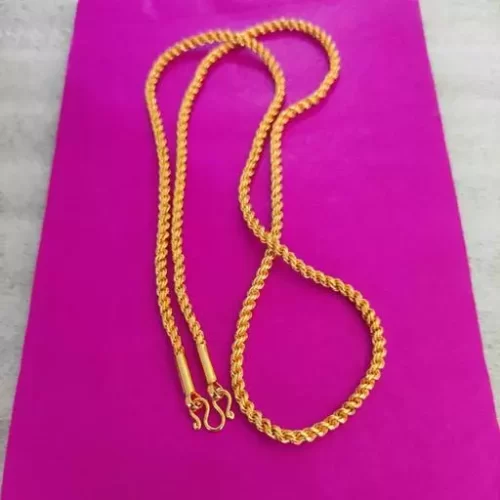
This chain is crafted with precision and attention to detail, showcasing the artistry of skilled goldsmiths. Each link of the chain is meticulously shaped and intertwined to create the appearance of a twisted rope, giving it a distinct and captivating look.

The symbolism of the Kayarpiri chain lies in its resemblance to a rope. In many cultures, the rope is considered a symbol of unity, strength, and resilience. It represents the unbreakable bond between individuals or communities, signifying their connection and support for one another.
Filigree Jewellery
Filigree jewellery has a timeless appeal and is highly popular in Kerala due to its intricate craftsmanship and exquisite beauty. The art of filigree work has a long-standing tradition in the state, and the skilled artisans of Kerala have perfected this delicate craft over generations.
The popularity of filigree jewellery in Kerala can be attributed to its unique and intricate designs that showcase the rich heritage and cultural aesthetics of the region. The patterns created through the interwoven fine wires or threads in filigree jewellery are often inspired by traditional motifs, nature, or geometric shapes.
These intricate patterns are a testament to the skill and precision of the artisans who meticulously create each piece.
In Kerala, filigree jewellery is often made using gold, as gold is highly valued and cherished in the state’s culture. The radiant glow of gold combined with the delicate filigree work creates a mesmerizing effect that captures the attention of jewellery enthusiasts. However, filigree jewellery can also be crafted using other metals such as silver, copper, and brass, catering to different preferences and budgets.
Filigree jewellery in Kerala encompasses a wide range of ornaments, including earrings, necklaces, bracelets, and rings. Each piece is a work of art, reflecting the intricacy and elegance of the filigree technique. The lightweight nature of filigree jewellery makes it comfortable to wear, allowing individuals to adorn themselves with elaborate designs without compromising on comfort.
Kadagam
The Kadaga, also known as the ‘Coorg Kada’ or ‘Coorg Bangle’, is a traditional piece of jewellery that holds cultural significance among the Kodava community of Coorg, a region in Karnataka, India. These bangles are an integral part of the Kodava attire and are often worn during special occasions and festivals.
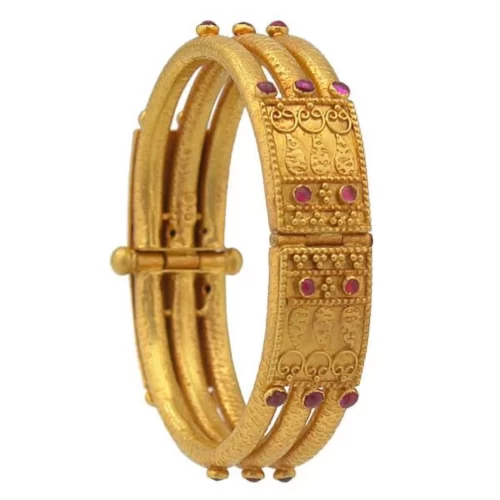
The Kadaga bangles are typically made of solid gold and feature a unique design. They come in various sizes and can be single, double, or even triple-tiered, depending on personal preference. The bangles are crafted to fit tightly around the wrist, accentuating its beauty and creating a distinctive style statement.
One notable feature of the Kadaga is the screw mechanism used to open and close the bangle. This screw adds a functional aspect to the jewellery, ensuring a secure and snug fit on the wrist. The intricate screw design is often adorned with decorative elements such as gemstones, engravings, or filigree work, enhancing the overall aesthetic appeal of the bangle.
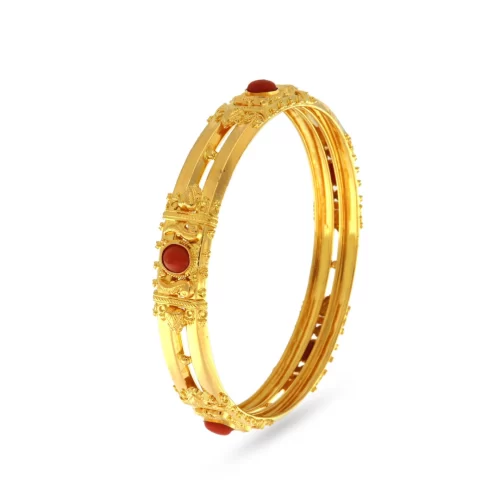
Traditionally, Kadaga bangles were made exclusively of gold, symbolizing prosperity and wealth. However, contemporary variations may incorporate other metals or embellishments to cater to different preferences and budgets. Despite the variations in materials and designs, the essence of the Kadaga remains intact, preserving its cultural and traditional significance.
For the Kodava community, the Kadaga bangle holds great sentimental value. It represents the heritage, customs, and pride of the community. These bangles are often considered heirlooms and are passed down through generations, symbolizing the continuity of family traditions and the bond between ancestors and descendants.
Cable chain
Cable chains have gained significant popularity in Kerala, thanks to their timeless design and versatility. The classic and elegant appearance of the cable chain makes it a preferred choice among individuals looking for a traditional yet stylish jewellery chain. The design of the cable chain resonates with the aesthetic preferences of the people in Kerala. The oval links that are interlocked create a visually appealing pattern that is both symmetrical and balanced. The uniform construction of the chain adds to its overall charm and durability, making it suitable for daily wear as well as special occasions.
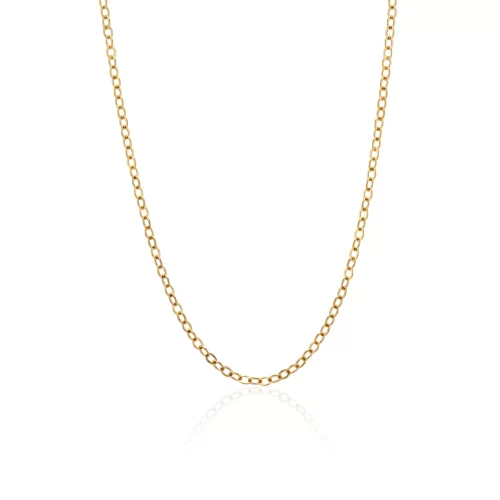
The versatility of cable chains is another factor that contributes to their popularity. They can be worn on their own as a simple and elegant accessory, or they can be adorned with pendants or charms to create a more personalized look. The thin variations of cable chains are particularly favored for pairing with pendants, allowing individuals to showcase their unique style and individuality. In addition to their aesthetic appeal, cable chains are known for their durability and strength. The interlocking links ensure that the chain remains secure and resistant to breakage, making it a reliable choice for everyday wear. This durability is highly valued in Kerala, where individuals seek long-lasting and high-quality jewellery pieces.
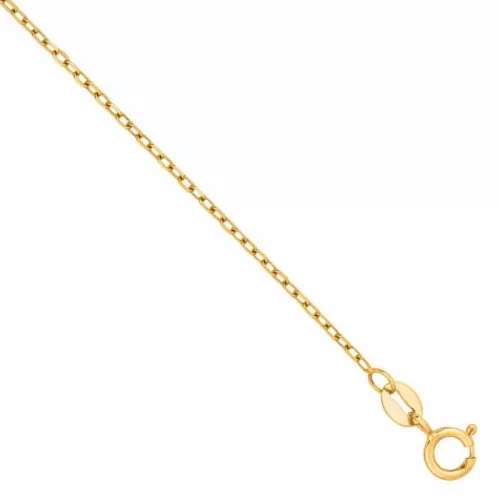
The versatility of cable chains is another factor that contributes to their popularity. They can be worn on their own as a simple and elegant accessory, or they can be adorned with pendants or charms to create a more personalized look. The thin variations of cable chains are particularly favored for pairing with pendants, allowing individuals to showcase their unique style and individuality. In addition to their aesthetic appeal, cable chains are known for their durability and strength. The interlocking links ensure that the chain remains secure and resistant to breakage, making it a reliable choice for everyday wear. This durability is highly valued in Kerala, where individuals seek long-lasting and high-quality jewellery pieces.
Curb chain
Curb chains have found popularity in Kerala as a timeless and versatile jewellery chain. The design of the curb chain features flattened and twisted links that interlock tightly, creating a distinctive pattern. This chain type offers a slight variation from the classic cable chain, making it a preferred choice for those seeking a unique and stylish look.
Curb chains are available in various thicknesses, ranging from very fine formations at around 1mm to chunkier variations. This versatility allows individuals to choose the curb chain that best suits their personal style and desired level of statement-making. The chunkier curb chains are particularly popular for creating bold and eye-catching necklaces, adding a touch of glamour to any outfit.
One of the most popular variations of the curb chain is the diamond cut curb chain. This type of curb chain features facets across the surface of each link, creating a sparkling and professional finish. The diamond cut enhances the visual appeal of the chain, adding a touch of elegance and sophistication.
Figaro chain
The Figaro chain has gained popularity in Kerala as a stylish and versatile jewellery chain, often worn by both men and women. The chain is also known under the name Sachin Chain – named under the legendary Cricketer Sachin Tendulkar. This chain features flattened links that are not uniform in size, creating an attractive and distinctive design. The Figaro chain originated in Italy and has become a beloved choice among jewellery enthusiasts worldwide.
The characteristic pattern of the Figaro chain consists of one elongated oval link followed by two or three shorter links of the same size. This alternating design adds visual interest and creates a sense of rhythm and balance within the chain. The contrast in sizes of the links further enhances the overall appeal of the Figaro chain, making it a preferred choice for those seeking a chain that stands out.
Figaro chains are available in a variety of sizes, thicknesses, and styles to cater to different preferences. The diamond cut Figaro chain is a popular variation that adds an extra touch of sparkle and elegance. The diamond cut technique creates facets on the surface of the links, allowing the chain to capture and reflect light, resulting in a captivating and eye-catching appearance. One of the reasons for the popularity of the Figaro chain is its versatility. It can be worn as a standalone piece or paired with pendants, crosses, or medallions to create a personalized and meaningful look. This flexibility allows individuals to express their unique style and preferences by adding various embellishments or charms to the chain.
Figaro chains are available in a variety of sizes, thicknesses, and styles to cater to different preferences. The diamond cut Figaro chain is a popular variation that adds an extra touch of sparkle and elegance. The diamond cut technique creates facets on the surface of the links, allowing the chain to capture and reflect light, resulting in a captivating and eye-catching appearance. One of the reasons for the popularity of the Figaro chain is its versatility. It can be worn as a standalone piece or paired with pendants, crosses, or medallions to create a personalized and meaningful look. This flexibility allows individuals to express their unique style and preferences by adding various embellishments or charms to the chain.
Ball chain
Ball chains, also referred to as bead chains, are a type of jewellery chain characterized by small spherical beads or balls that are connected together to form a continuous chain. The beads in a ball chain are typically uniform in size and are placed adjacent to each other at regular intervals, creating a distinctive and eye-catching pattern.
The beads in a ball chain can be made from various materials, such as metal, plastic, or even natural materials like wood or stone. The most common material used for ball chains is metal, particularly stainless steel, sterling silver or gold, as they offer durability and a polished appearance.
Ball chains are known for their flexibility and ability to drape smoothly when worn. The small beads allow for easy movement and create a fluid appearance when the chain is draped around the neck, wrist, or ankle. The uniformity of the beads gives the chain a sleek and contemporary look, making it suitable for various jewellery styles and designs.
Ball chains are known for their flexibility and ability to drape smoothly when worn. The small beads allow for easy movement and create a fluid appearance when the chain is draped around the neck, wrist, or ankle. The uniformity of the beads gives the chain a sleek and contemporary look, making it suitable for various jewellery styles and designs.
Trace chain
Trace chain, also known as fine chain, is a delicate and elegant type of chain necklace characterized by its fine and small links. The links in a trace chain are typically round or oval-shaped and uniform in size, with each link measuring no wider than 2mm. The small size of the links gives the chain a subtle and refined appearance.
Trace chains are often chosen for their delicate and lightweight nature, making them ideal for creating delicate charm necklaces or layering with other chains. The fine links allow for a dainty and feminine look, adding a touch of elegance to any outfit. Due to their delicate nature, trace chains are generally more suitable for lighter pendants or charms.
One of the advantages of trace chains is their versatility. They are available in various thicknesses, allowing you to choose the right chain to suit your desired style or pendant size. Thinner trace chains are perfect for creating a minimalistic and understated look, while slightly thicker trace chains can provide more presence and durability.
Belcher chain
Belcher chain, also known as rolo chain, is a type of trace or link chain that features broad and uniform D-shaped links. The links in a belcher chain are typically interlocked and soldered together, creating a sturdy and versatile chain.
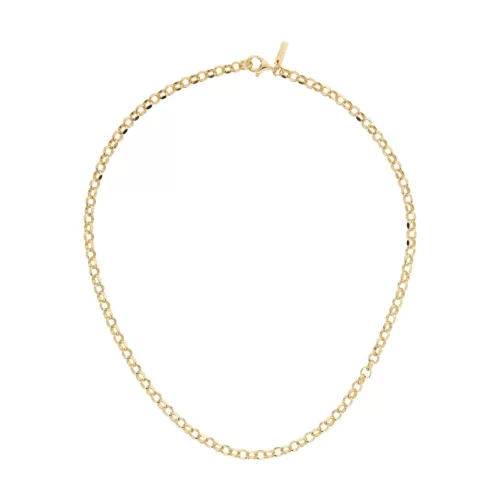
Belcher chains are available in various sizes and alloys, allowing for customization and personalization. They can be worn alone as a simple and understated necklace or stacked and layered with other chain necklaces for a more elaborate and fashionable look. This versatility is one of the reasons why belcher chains are among the most popular types of chain jewellery.
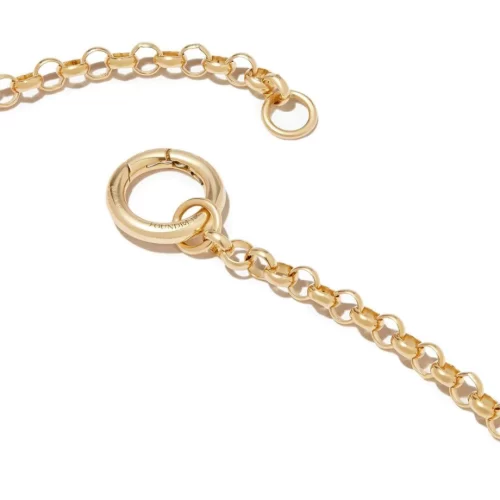
The origin of the name “belcher chain” has a couple of theories. One theory suggests that it was named after belcher scarves and rings that were popular during the 19th century. These accessories, often called “scarf rings,” were used to secure lightweight scarves around the neck. The interlocking rings of the belcher chain were believed to be inspired by the design of these scarf rings. Another theory is that belcher chains were named after James “Jem” Belcher, a famous bare-knuckle boxer who held the title of “Champion of All England” from 1800 to 1805. It is believed that the chain was named in honor of his prominence and popularity during that time.
Box chain
Box chain, also known as Venetian chain, is a type of chain necklace characterized by its square-shaped links. Unlike other chains with round links, the box chain features links that resemble small boxes, giving it a distinctive and structured appearance.
To create a box chain, round wire is first flattened and then shaped into the form of small cubes or boxes. These individual boxes are then linked together, creating a sturdy chain with a consistent and uniform look. The links interlock tightly, resulting in a smooth and sleek chain design.
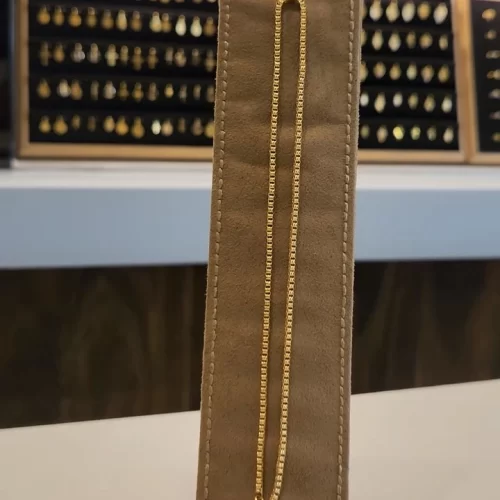
Box chains offer versatility in terms of thickness and length, allowing for various style options. They can be worn as standalone necklaces for a minimalistic and modern look, or they can be adorned with larger pendants or charms that can easily attach to the box-like links. When selecting or creating a pendant for a box chain, it’s important to ensure that the bail or loop is large enough to accommodate the size and shape of the box chain links.
The term “Venetian chain” is sometimes used interchangeably with box chain, as it is believed to have originated in Venice, Italy. The craftsmanship and precision required to create box chains reflect the skill and artistry of Venetian jewelers.
Snake chain
Snake chain, also known as Brazilian chain, is a type of chain necklace that is characterized by its flexible tubular shape and smooth, scale-like texture, resembling the skin of a snake. It is created by tightly weaving lightly curved plates or bands with thin links to form a continuous and sleek chain.

The name “snake chain” is derived from its resemblance to the body of a snake and its ability to move and flex with ease, thanks to its flexible construction. The tightly woven rings or plates give the chain its distinctive texture, which adds an elegant and sophisticated touch to any jewelry piece.
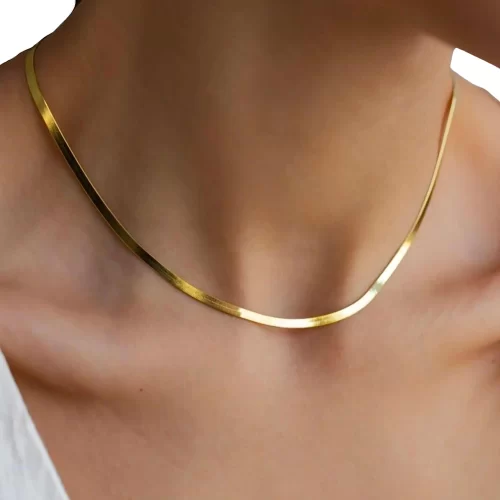
Snake chains are popular among jewelry makers and wearers alike. They are available in a variety of lengths, allowing for versatility in styling. Snake chains can be worn as standalone necklaces, where the chain itself becomes the focal point, or they can be combined with pendants to create stunning and eye-catching necklaces.
One of the advantages of snake chains is their flexibility, which allows them to conform to the curves of the body and sit comfortably on the neckline. This flexibility also contributes to their durability, making them less prone to kinks and tangles compared to other chain types.
Kemp jewellery
Kemp jewellery, also known as Kempu jewellery, is a traditional form of South Indian jewellery that is adorned with kempu stones. These stones are typically red in color, but can also be found in shades of blue or green. The intricate designs and vibrant colors of kemp jewellery make it a beloved choice among women in South India, especially for special occasions such as weddings and dance performances.
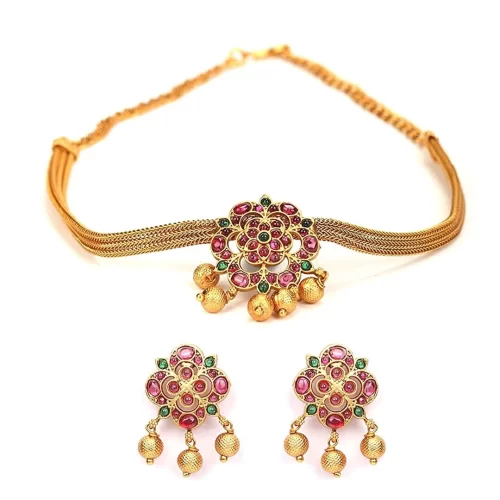
Originally, kemp jewellery was created to adorn the royals of South India, who later donated these exquisite pieces to temples. Over time, temple dancers like those in Bharatanatyam and Kuchipudi began wearing them, and the designs became an integral part of their dance jewellery. This is why kemp jewellery is sometimes referred to as Temple Jewellery or Dance Jewellery.
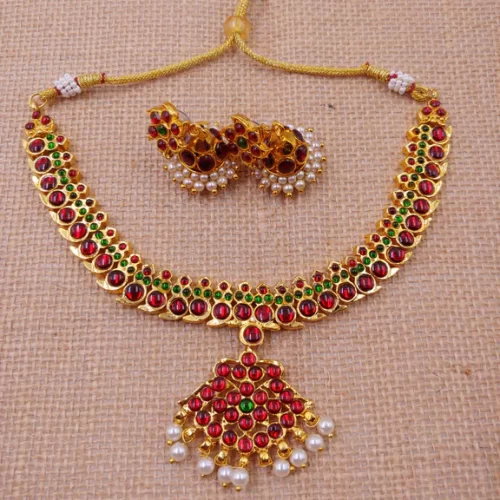
The resurgence of kemp jewellery in recent years has seen a rise in its popularity. Many brands now exclusively offer kemp jewellery, catering to the growing demand for these stunning pieces. Kemp jewellery showcases the rich cultural heritage and craftsmanship of South India, with intricate detailing, elaborate designs, and the use of colored stones.
A significant feature of kemp jewellery is the kempu stone itself. These stones are carefully set in the jewellery, adding a touch of elegance and charm. The craftsmanship involved in creating kemp jewellery is highly skilled, with artisans dedicating their expertise to handcrafting each piece.
Lariat necklace
A lariat necklace is a versatile and stylish piece of jewellery that adds an elegant touch to any outfit. It is characterised by its long, linear design and often features a decorative drop, such as a tassel, bar, or string of beads. The name “lariat” comes from the resemblance of the necklace’s shape to that of a lasso or lariat used in western-style roping.
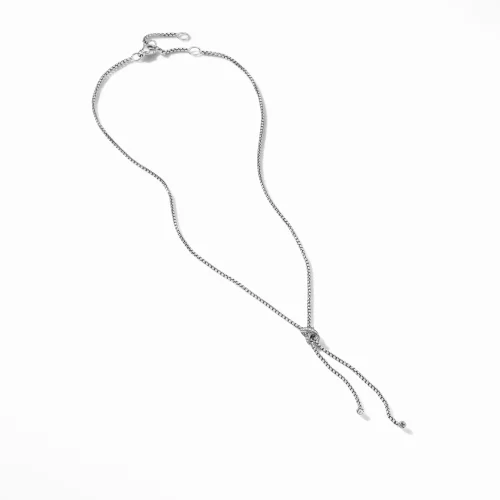
The elongated shape of the lariat necklace gives it a flattering and elongating effect when worn. It can be adjusted and styled in various ways, making it suitable for different necklines and occasions. The length of the necklace allows for creative and personalised styling options.

Lariat necklaces are popular for their versatility and ability to enhance both casual and formal looks. They can be worn as standalone statement pieces or layered with other necklaces for a trendy and layered effect. The decorative drop at the end of the necklace adds visual interest and creates a focal point that draws attention to the neckline.
Chandraharam necklace
Chandraharam necklace is a traditional South Indian necklace known for its regal and royal appearance. The name “Chandraharam” is derived from the combination of two words: “Chandra,” meaning moon, and “haram,” meaning necklace. The necklace is designed to resemble the shape of a crescent moon, with long layered strands and intricate motifs on the sides.

Chandraharam necklaces are typically crafted using gold and adorned with precious gemstones, pearls, or intricate filigree work. The necklace is designed to be worn close to the neckline, draping gracefully around the neck. The layered design adds depth and dimension to the necklace, creating a luxurious and majestic look.
The motifs on the sides of the Chandraharam necklace are often inspired by traditional South Indian designs, such as peacocks, flowers, leaves, or intricate geometric patterns. These motifs are intricately crafted and add to the overall beauty and elegance of the necklace.
In conclusion, there are inumerous designs that the malayalee community still holds close their hearts. We will keep updating this list as we come across new designs to keep you posted on the current trends.


